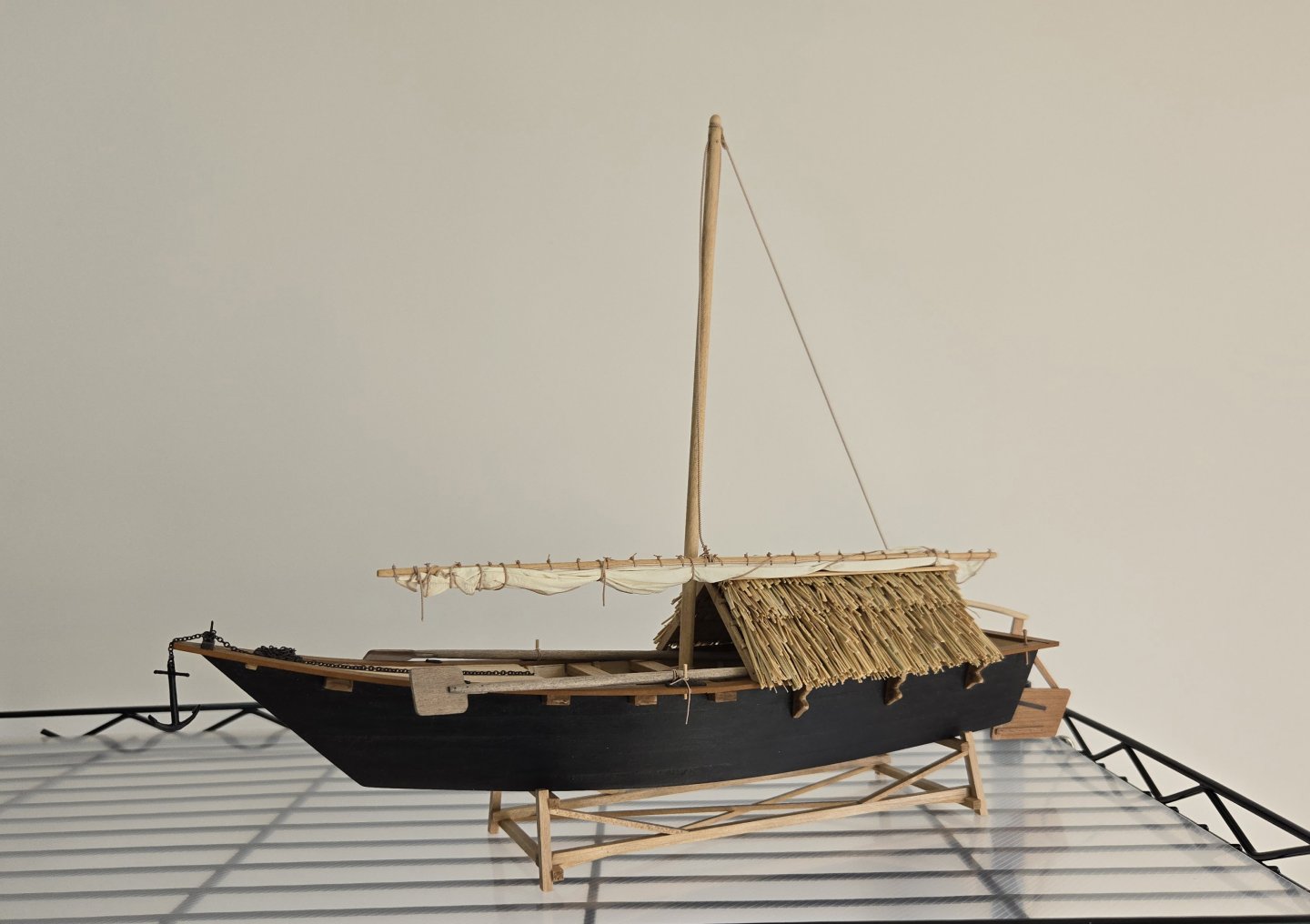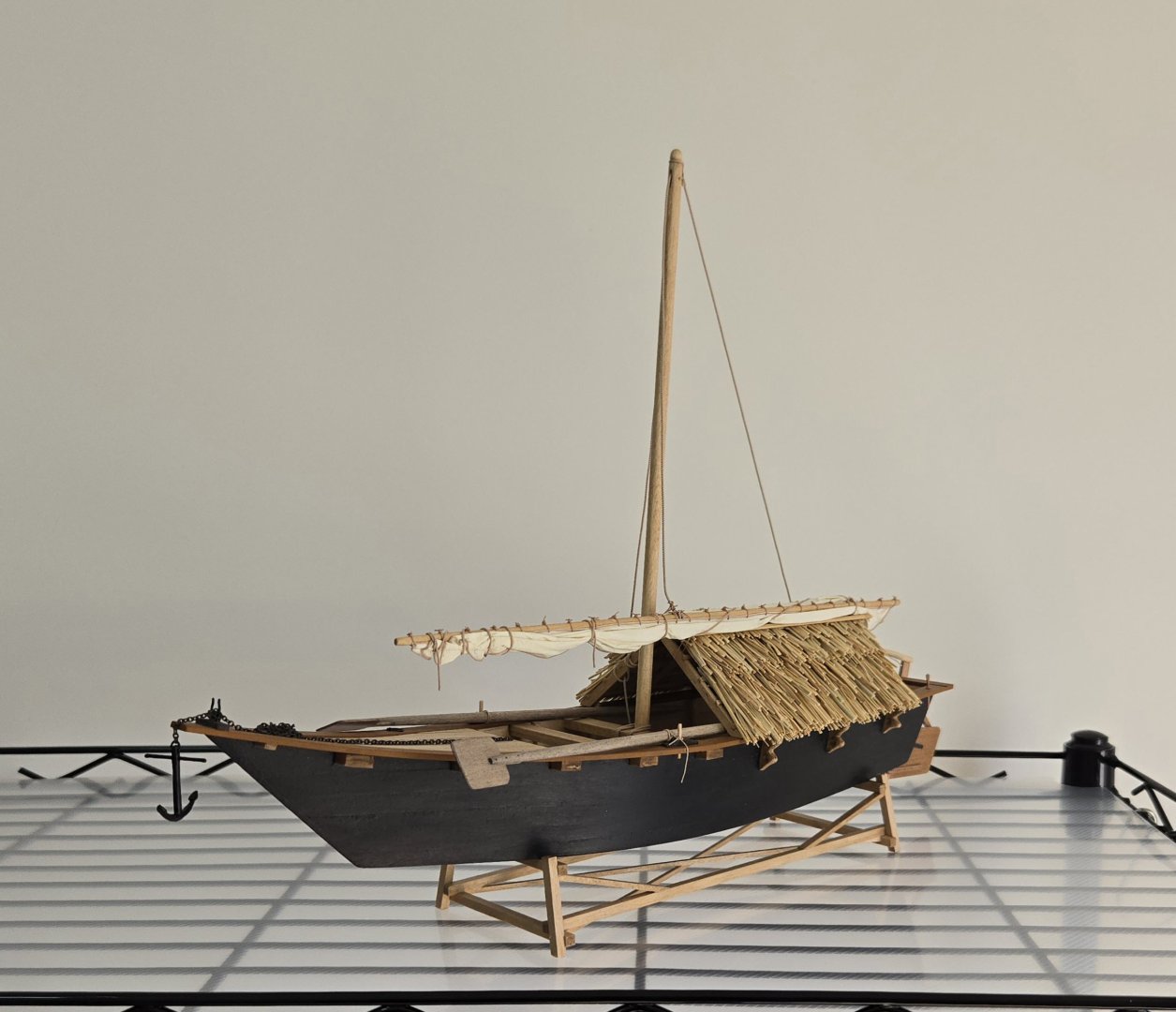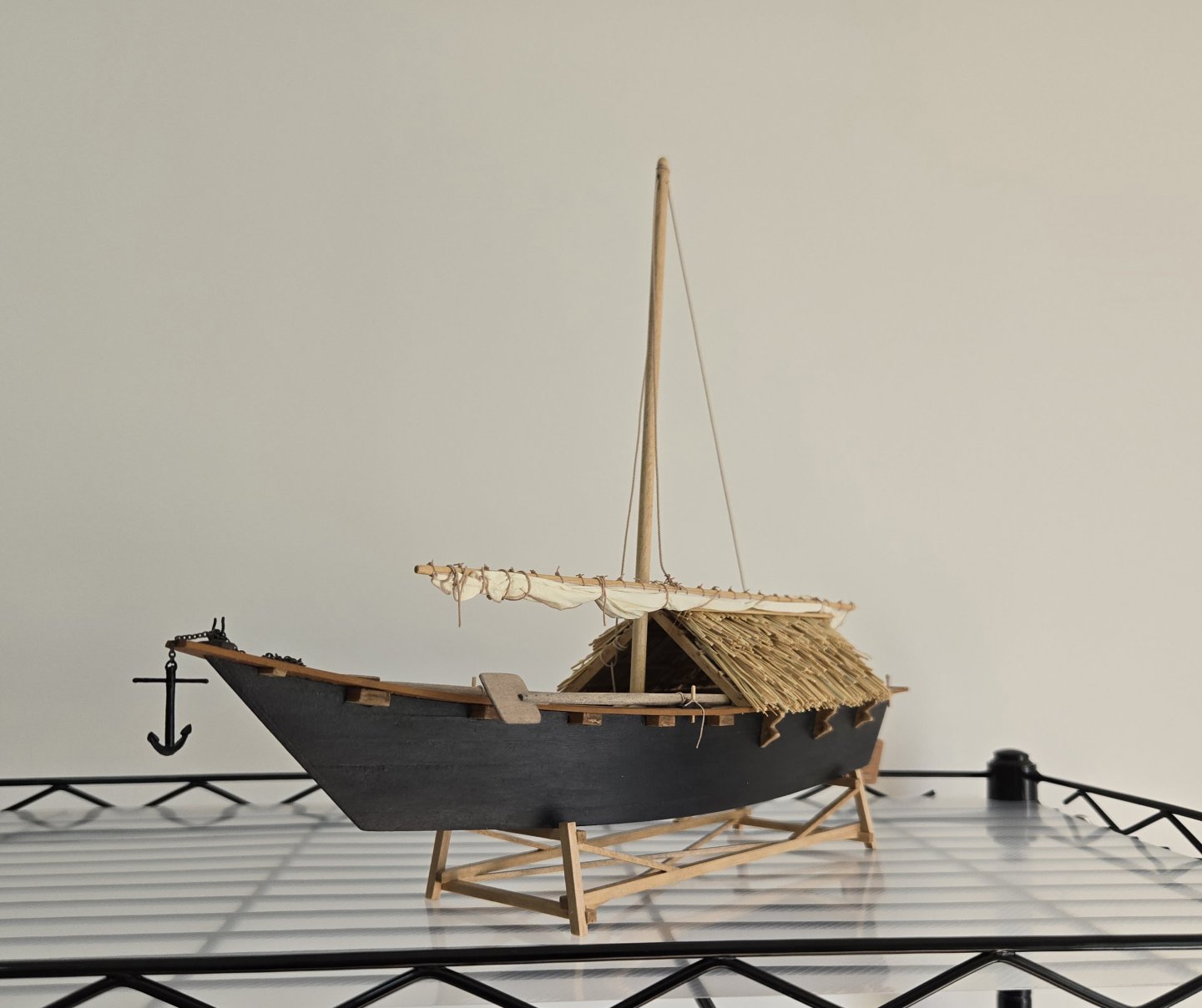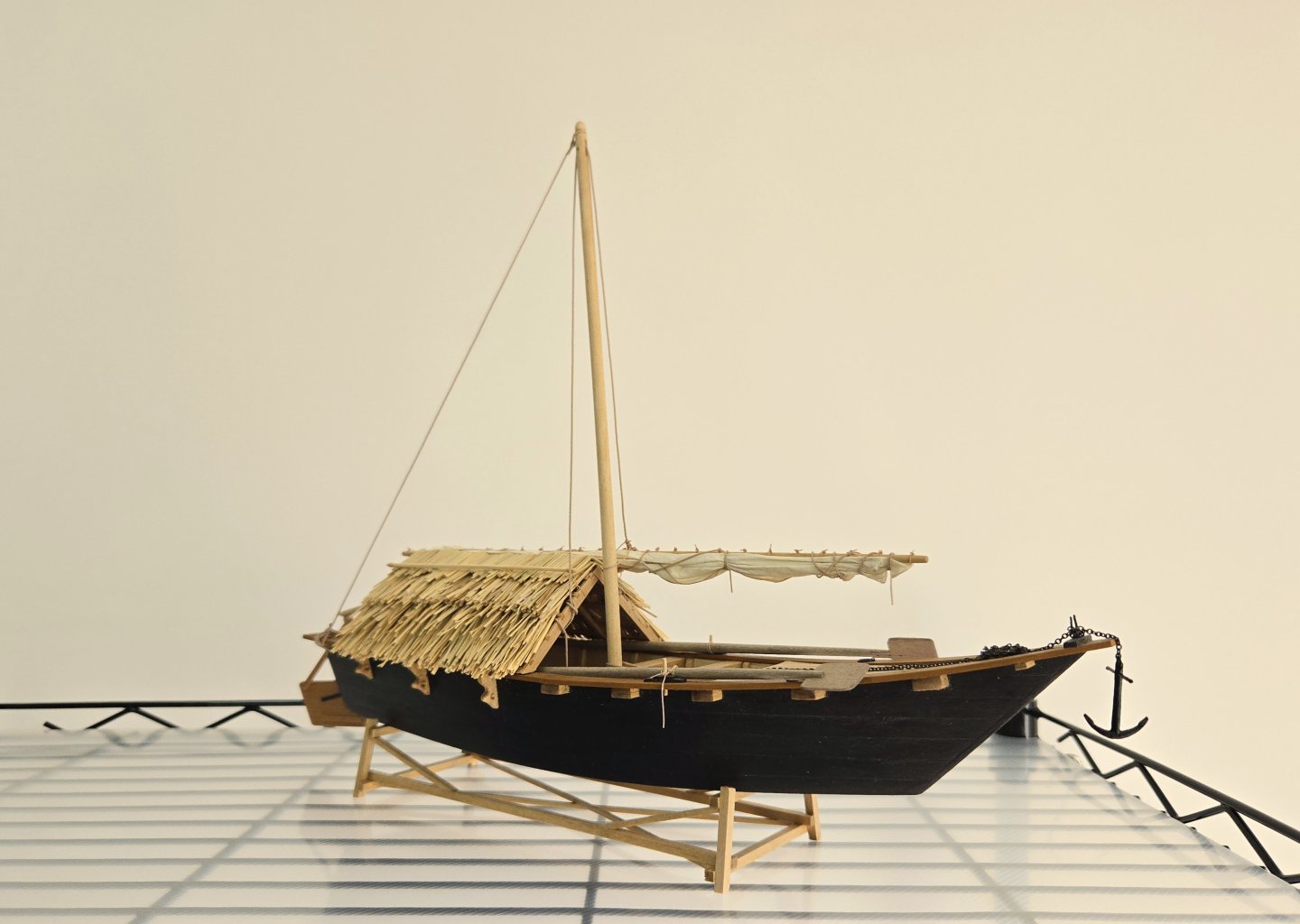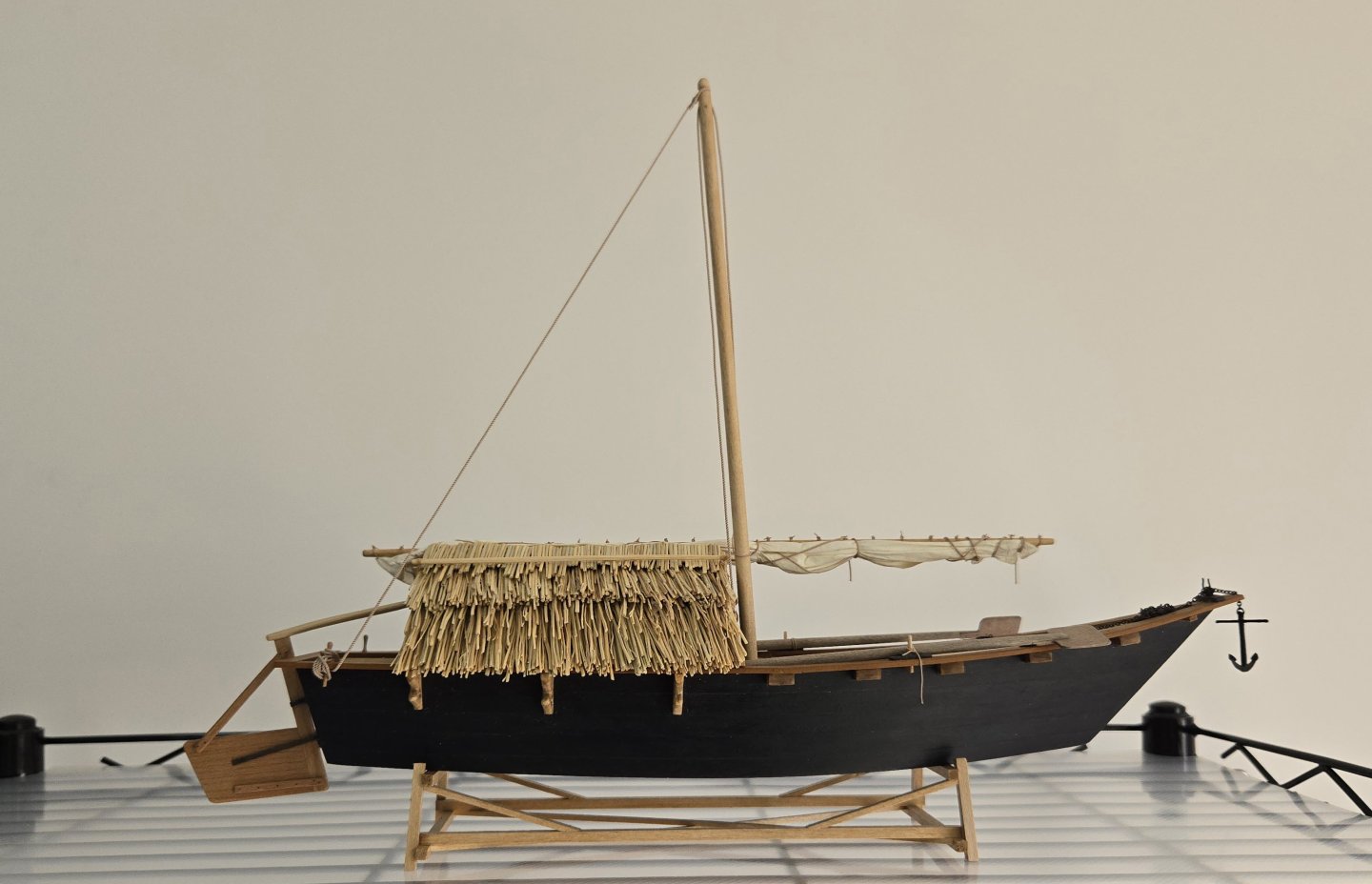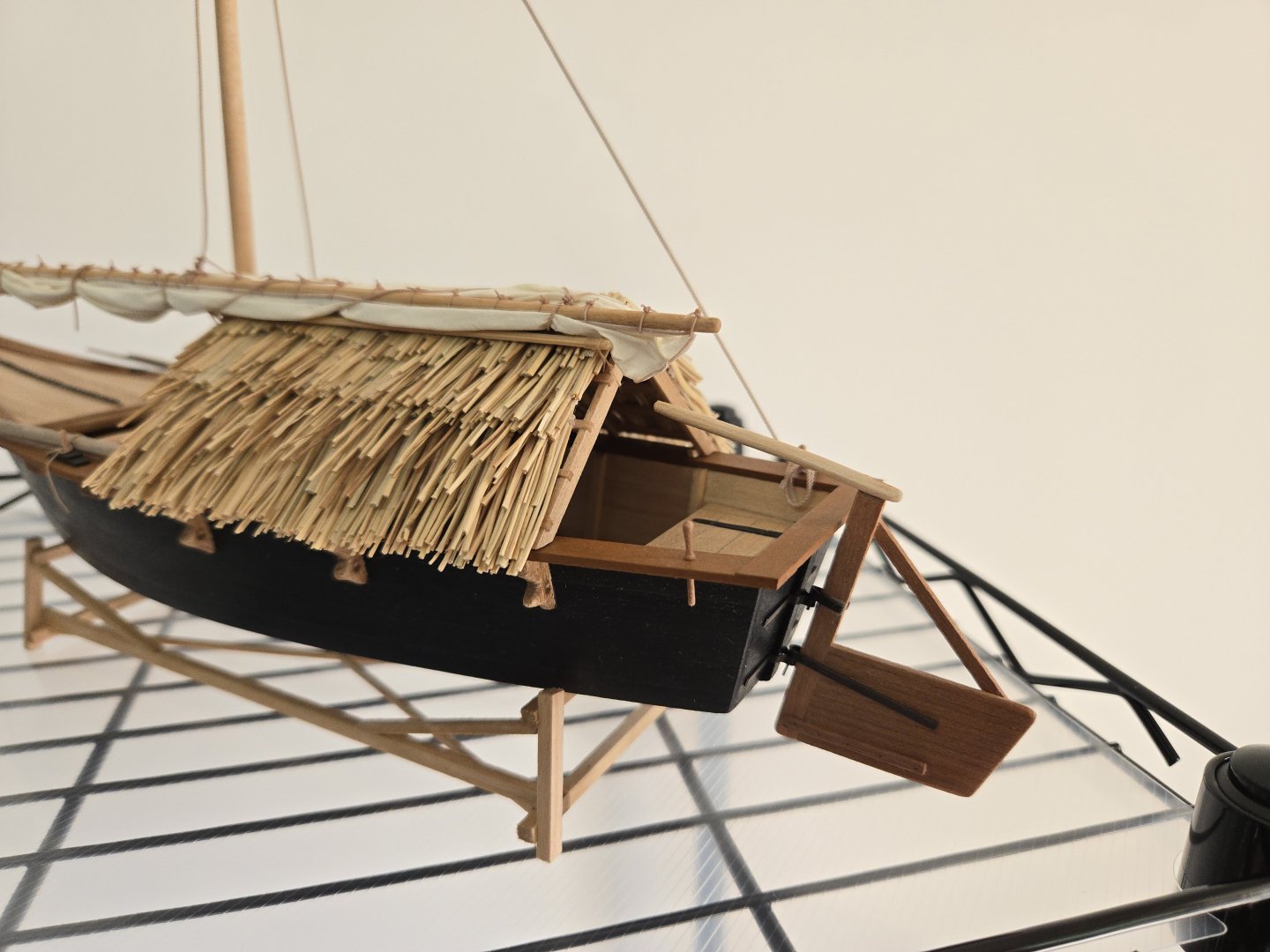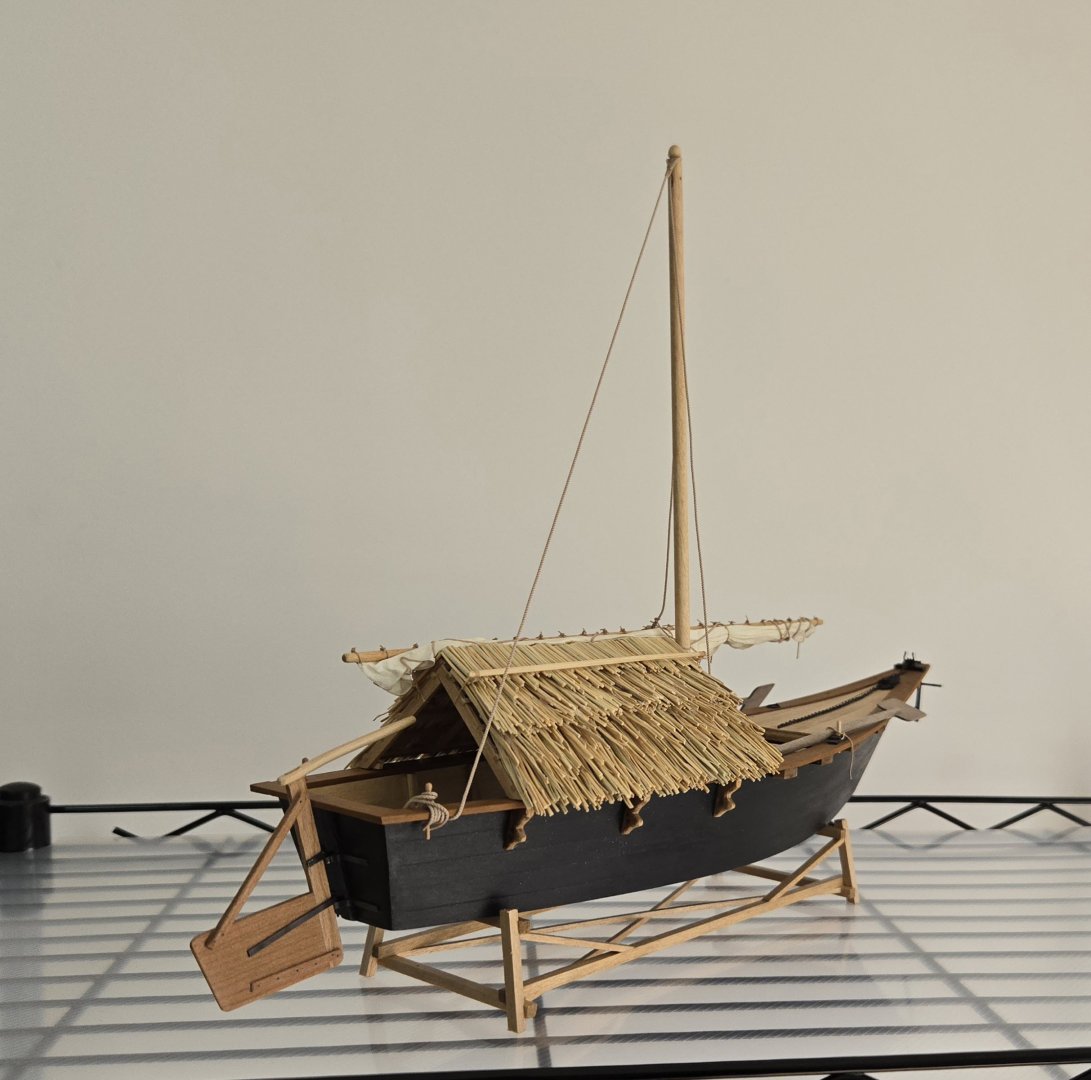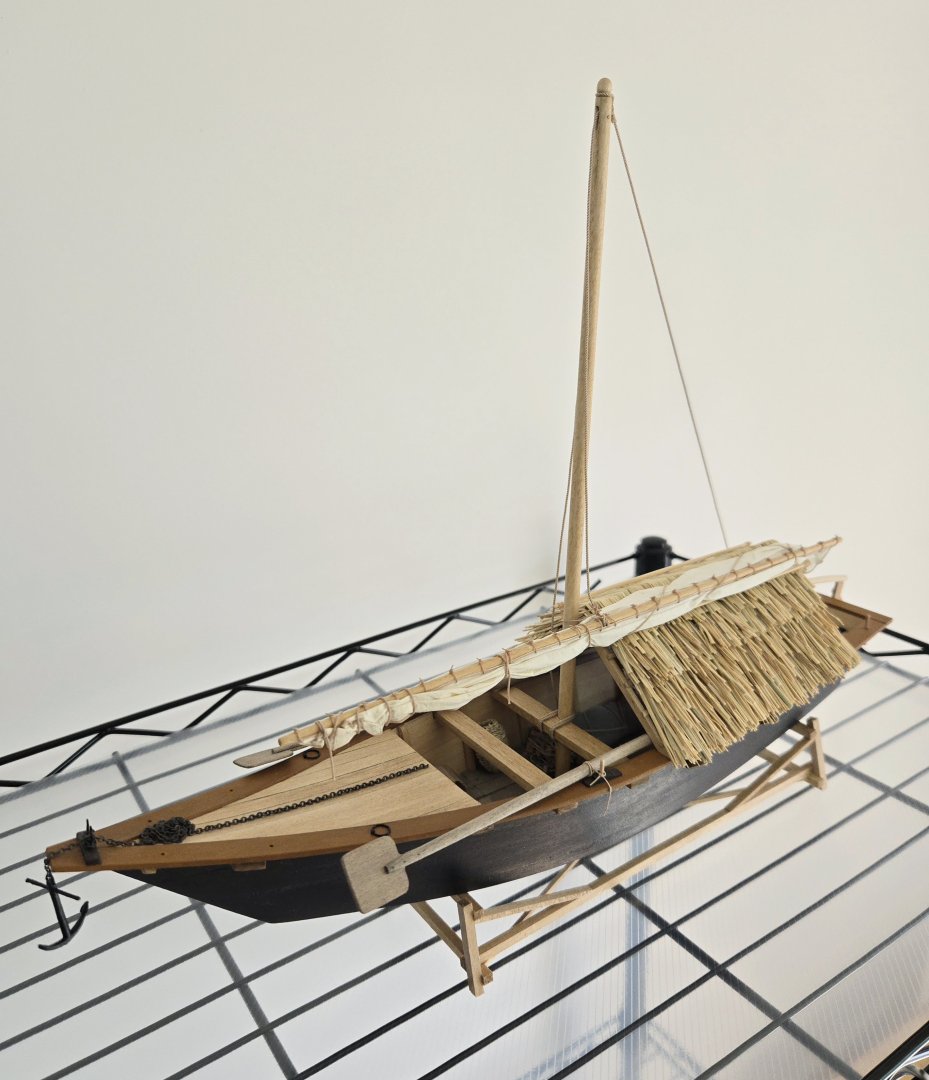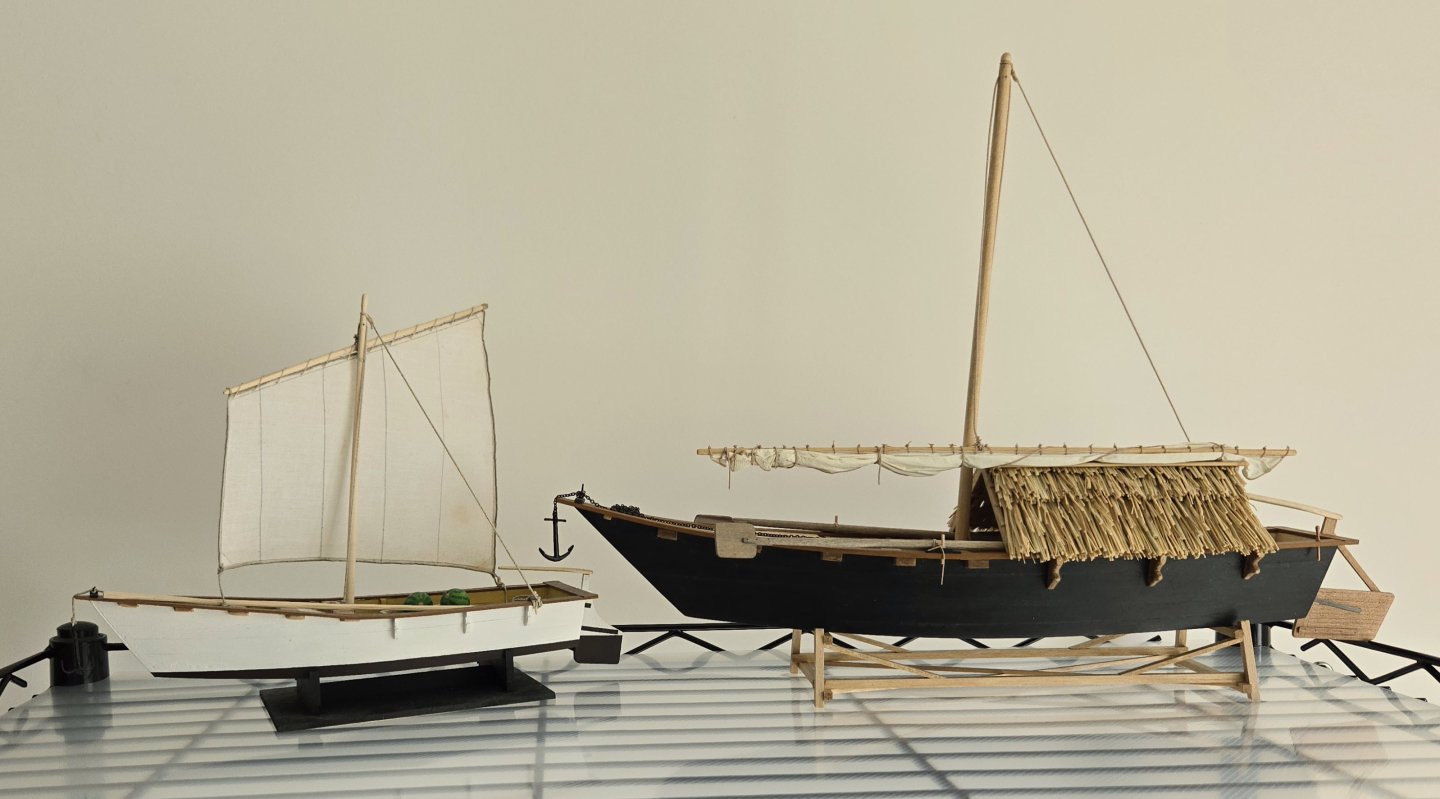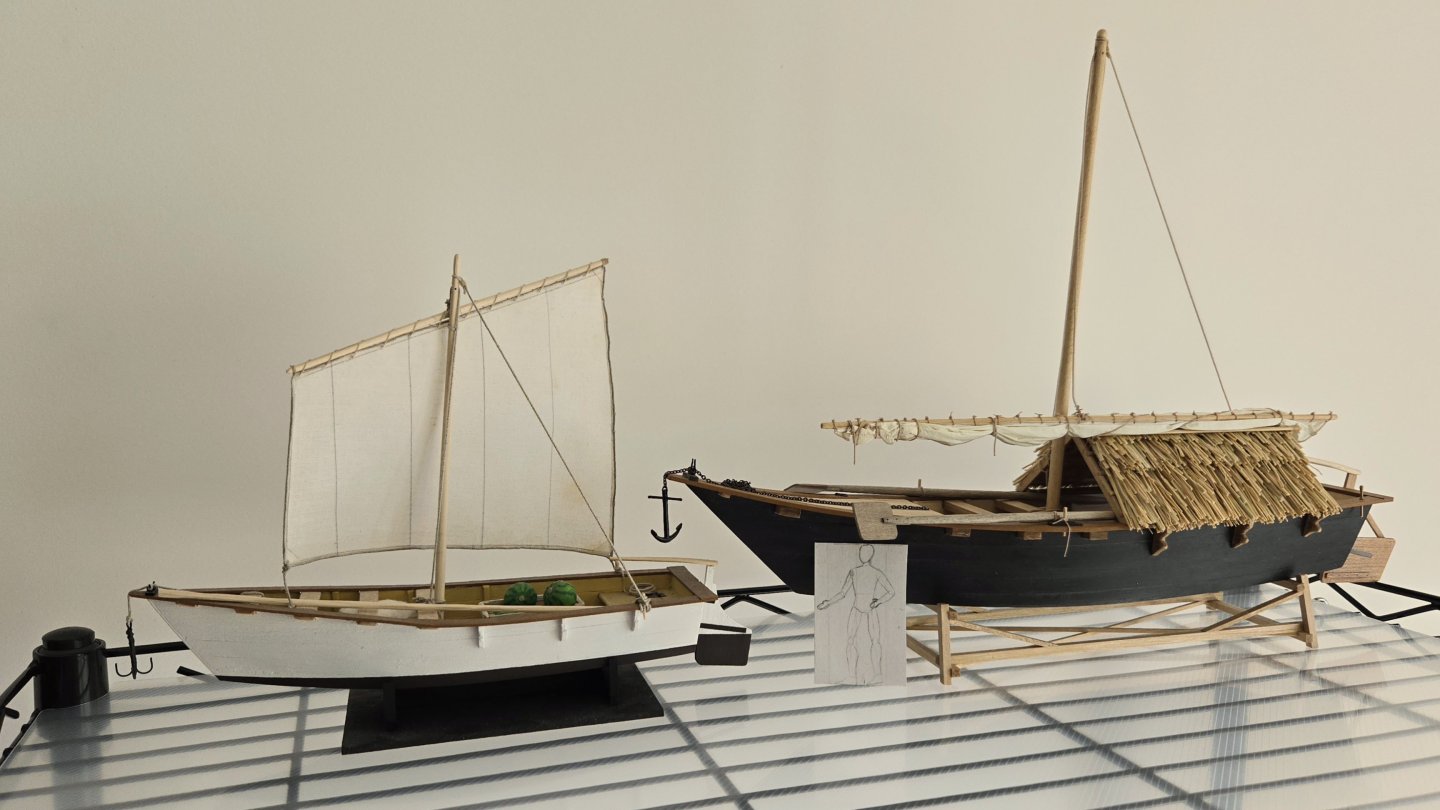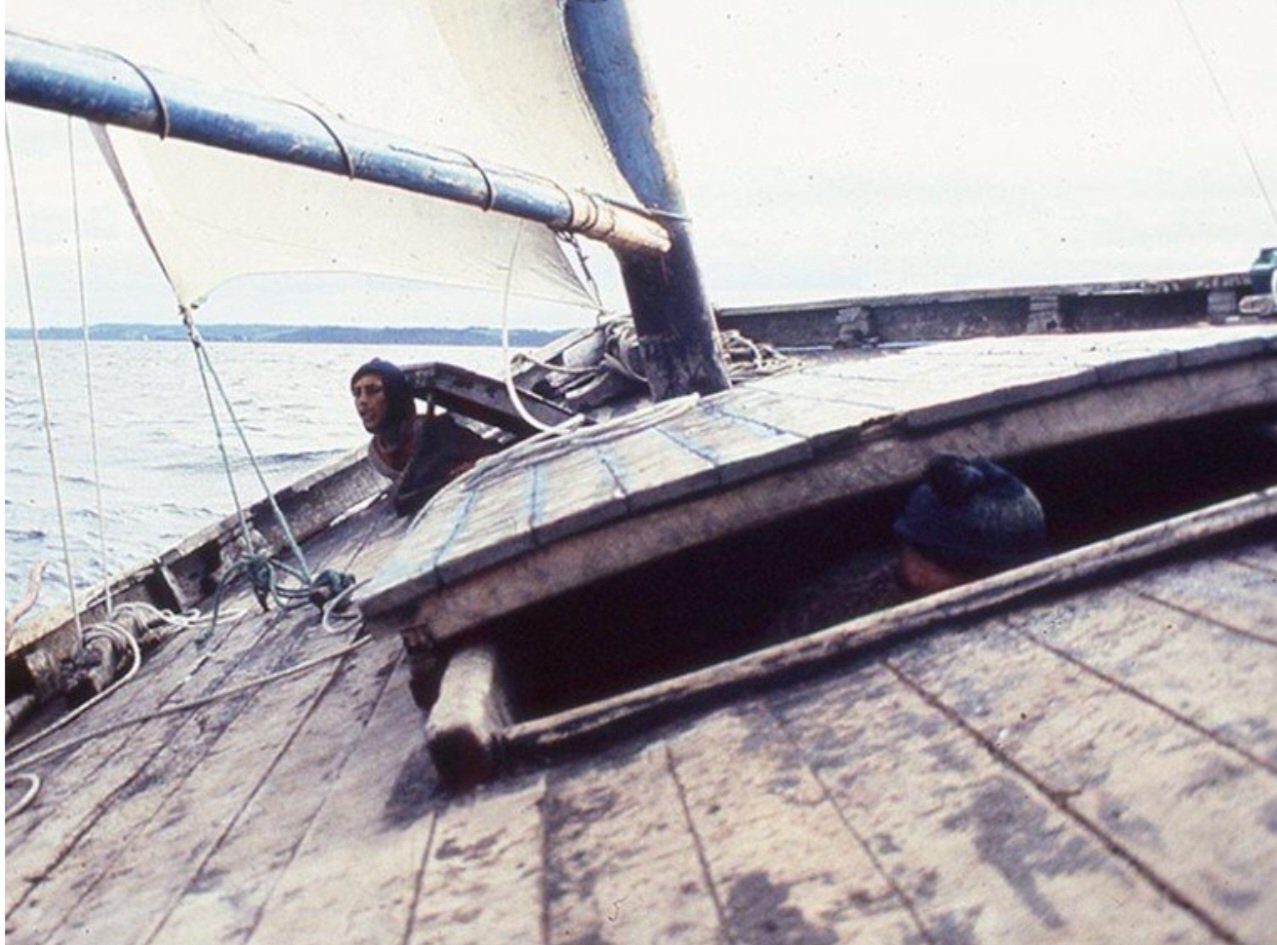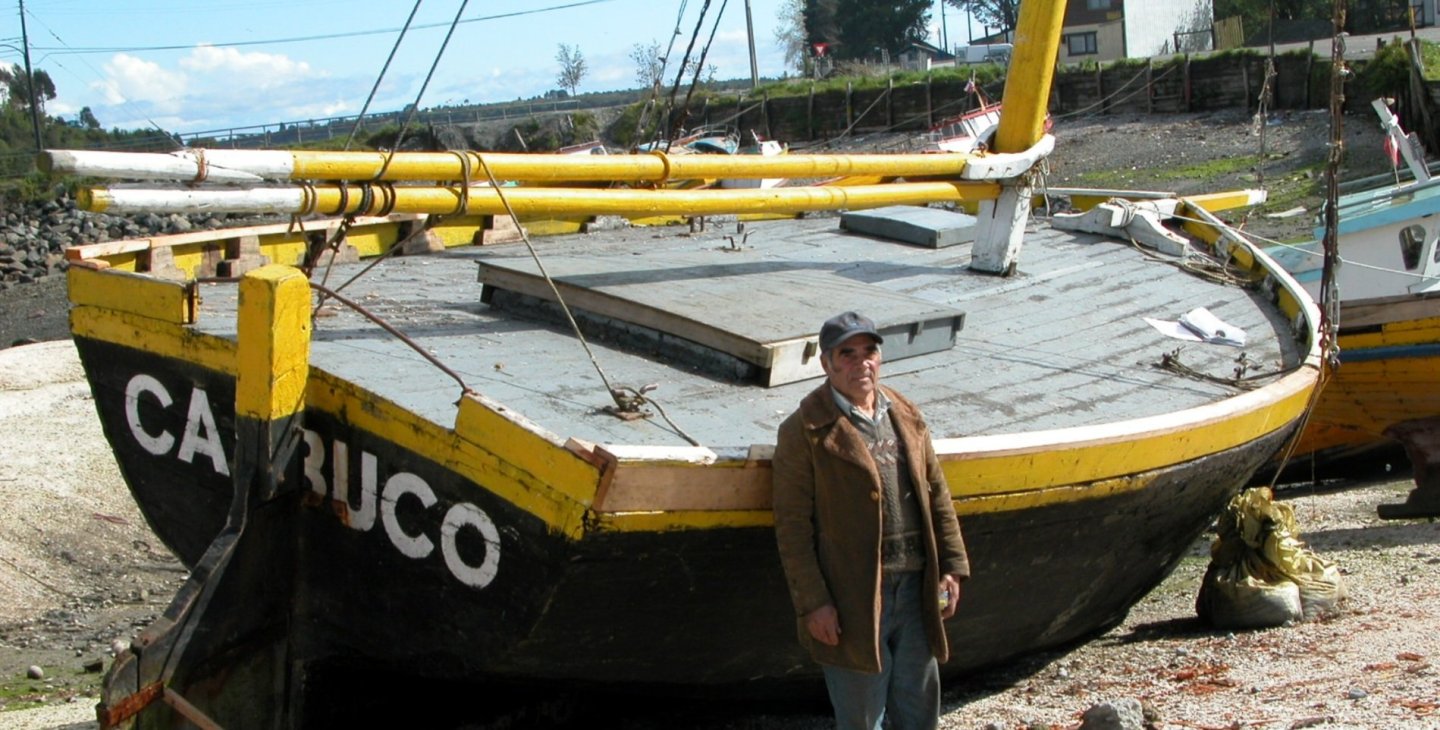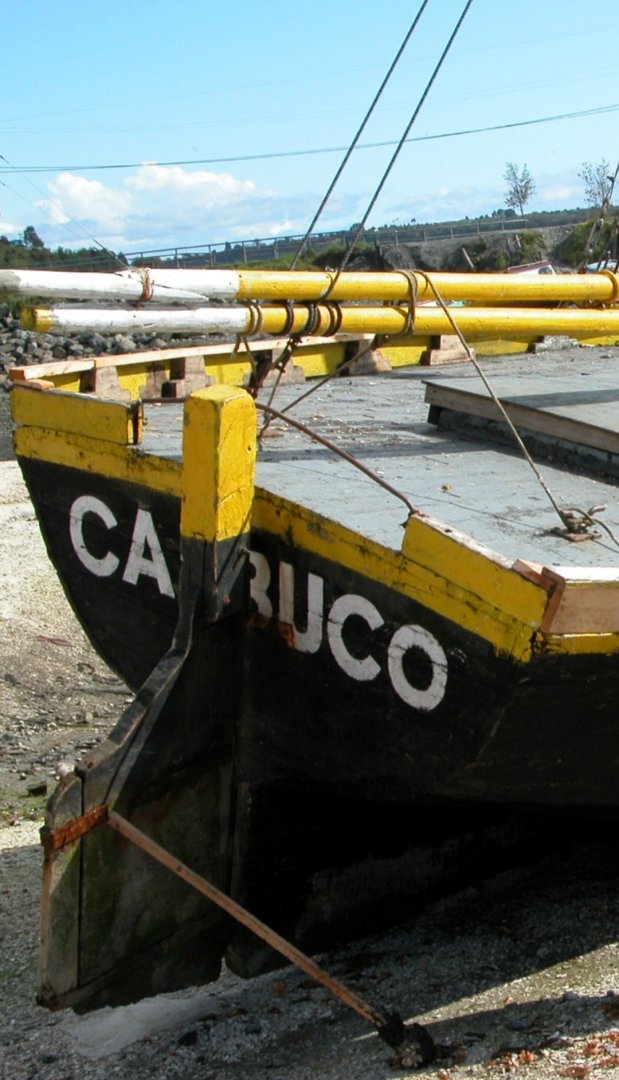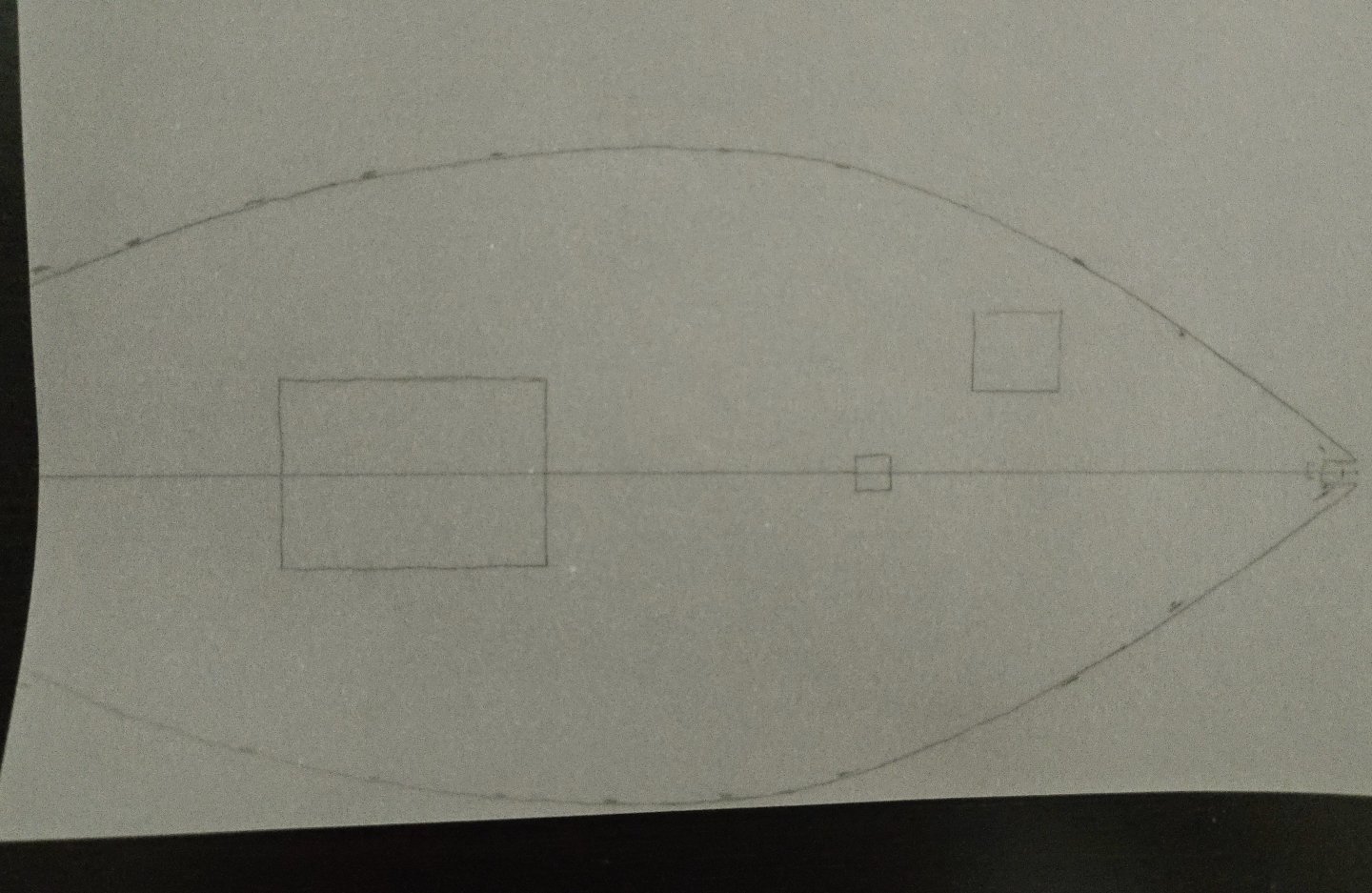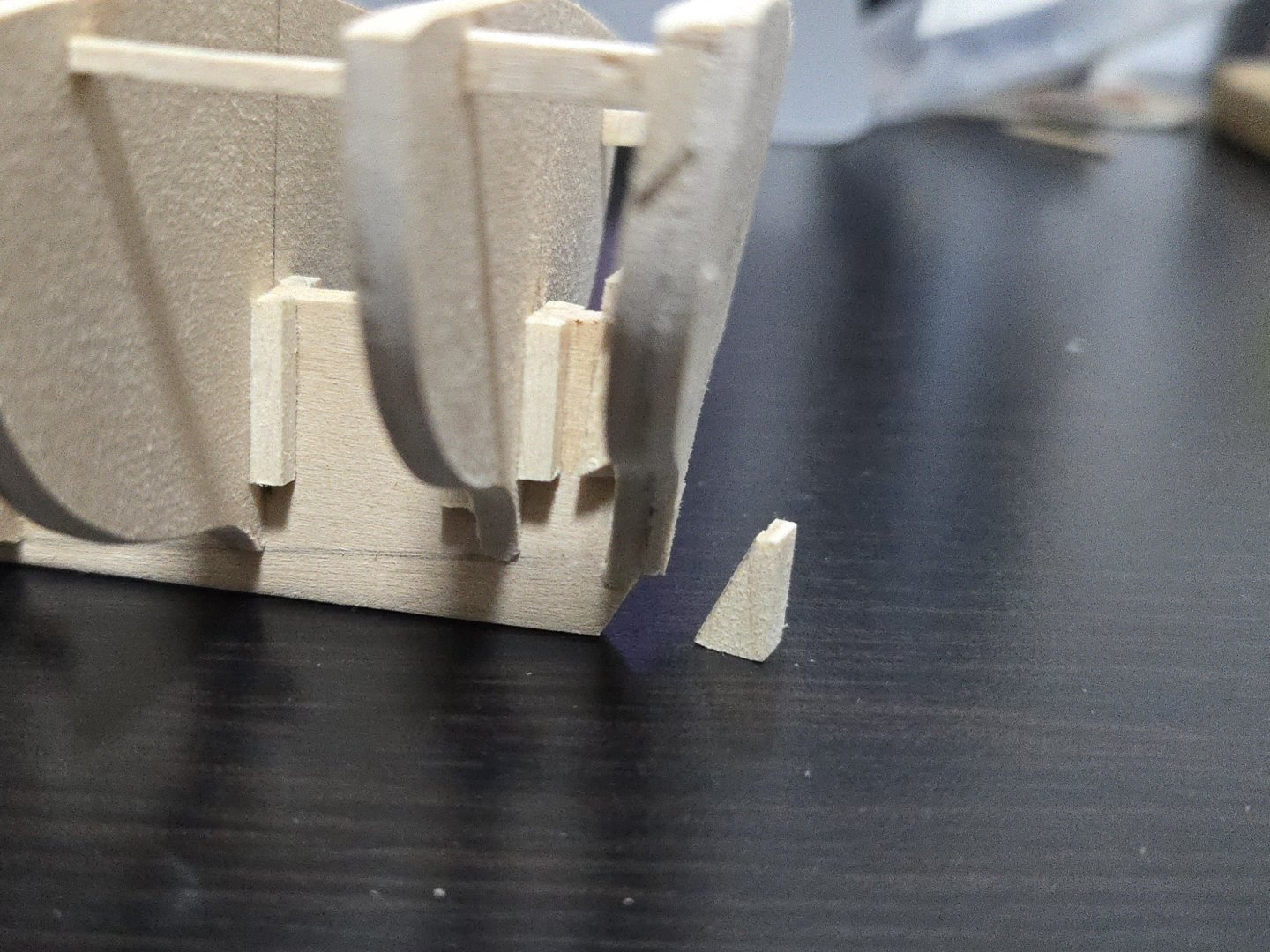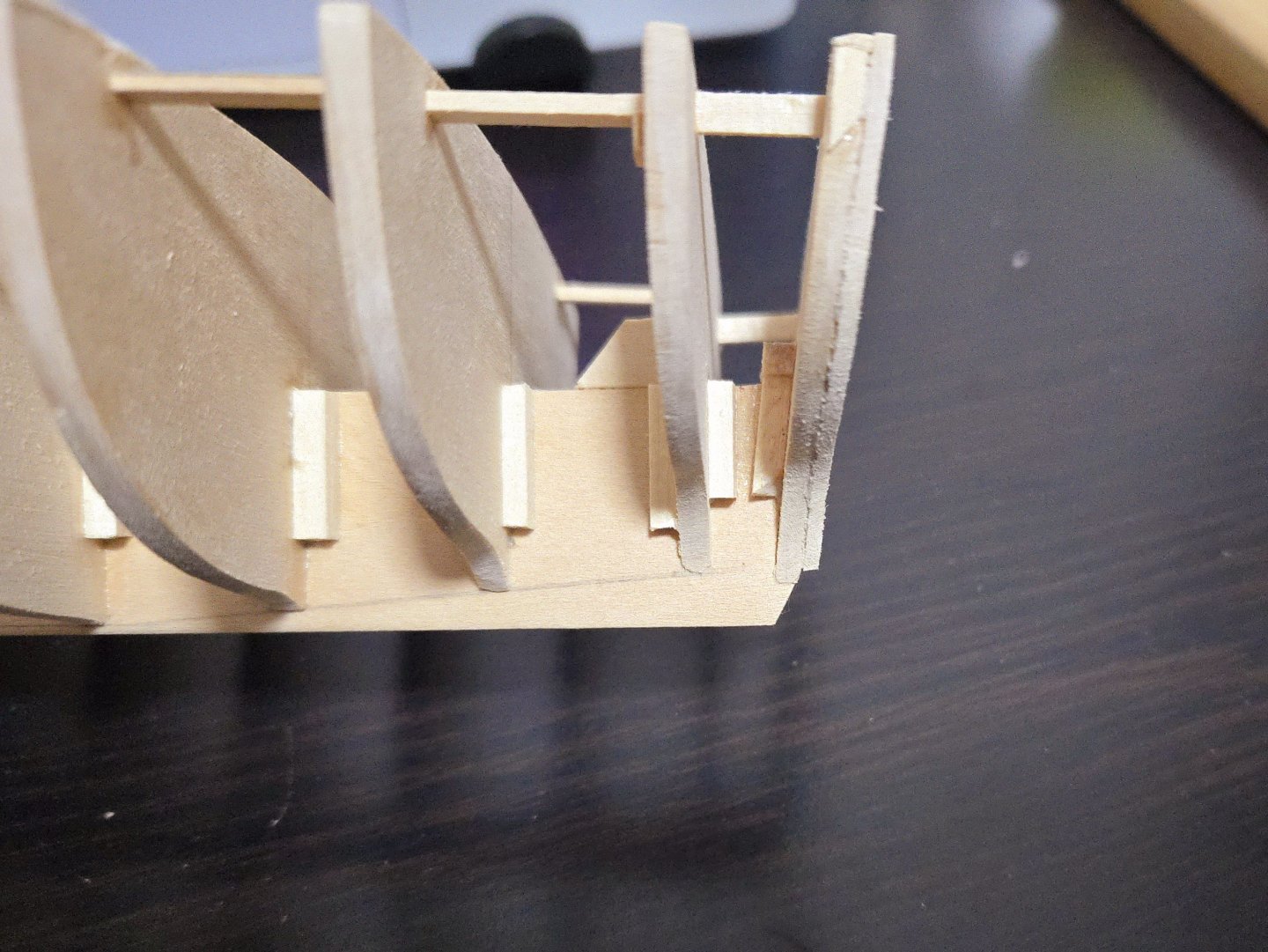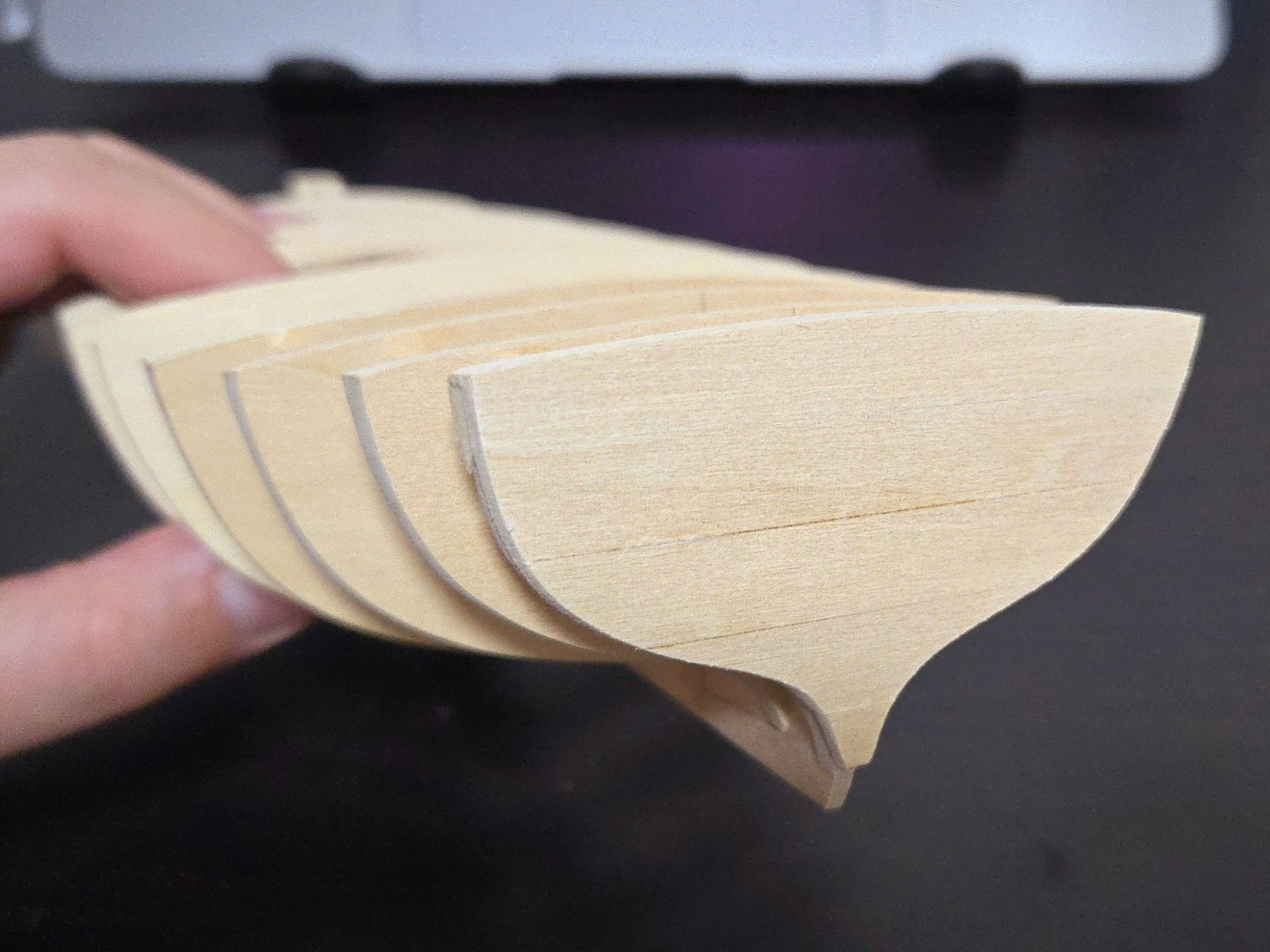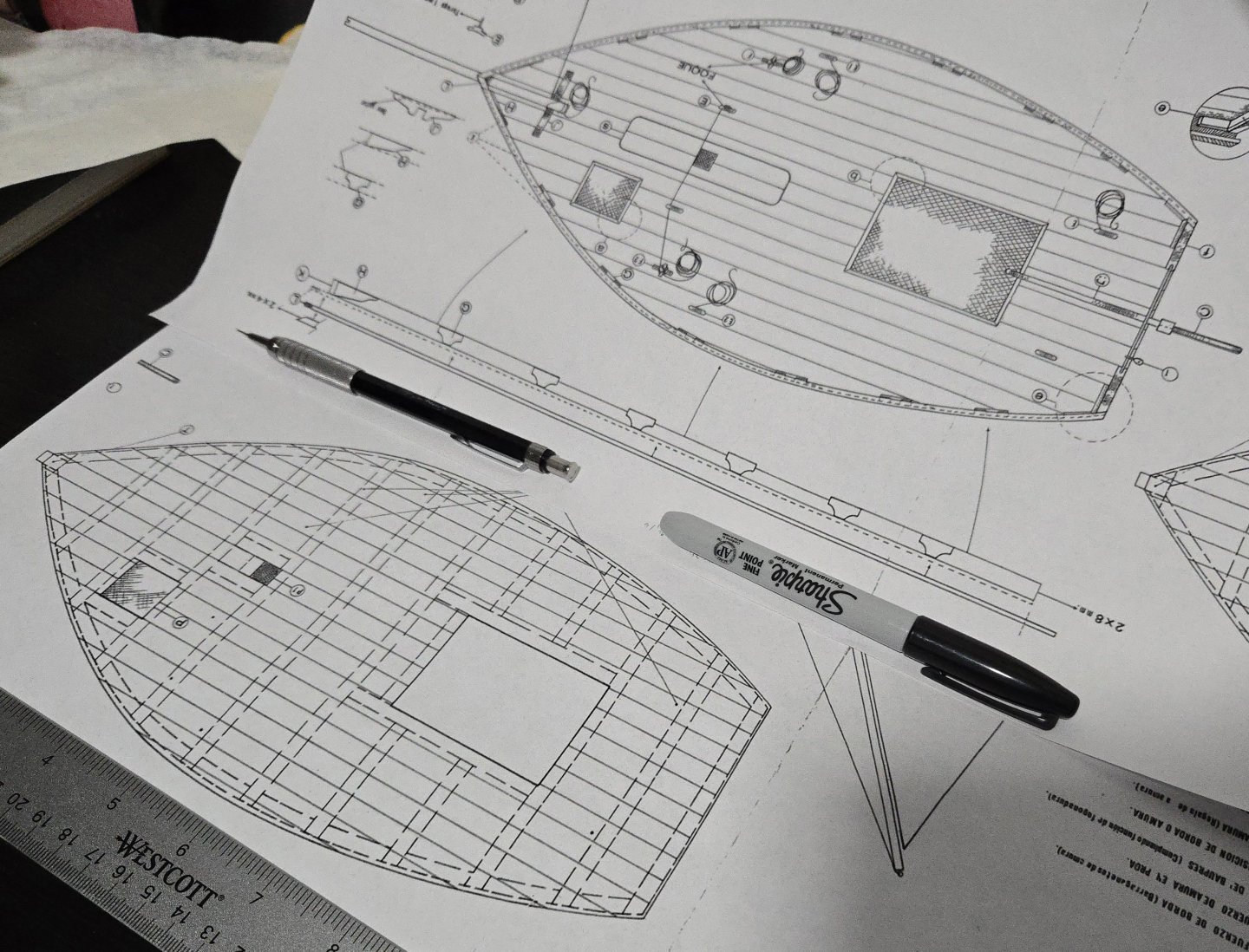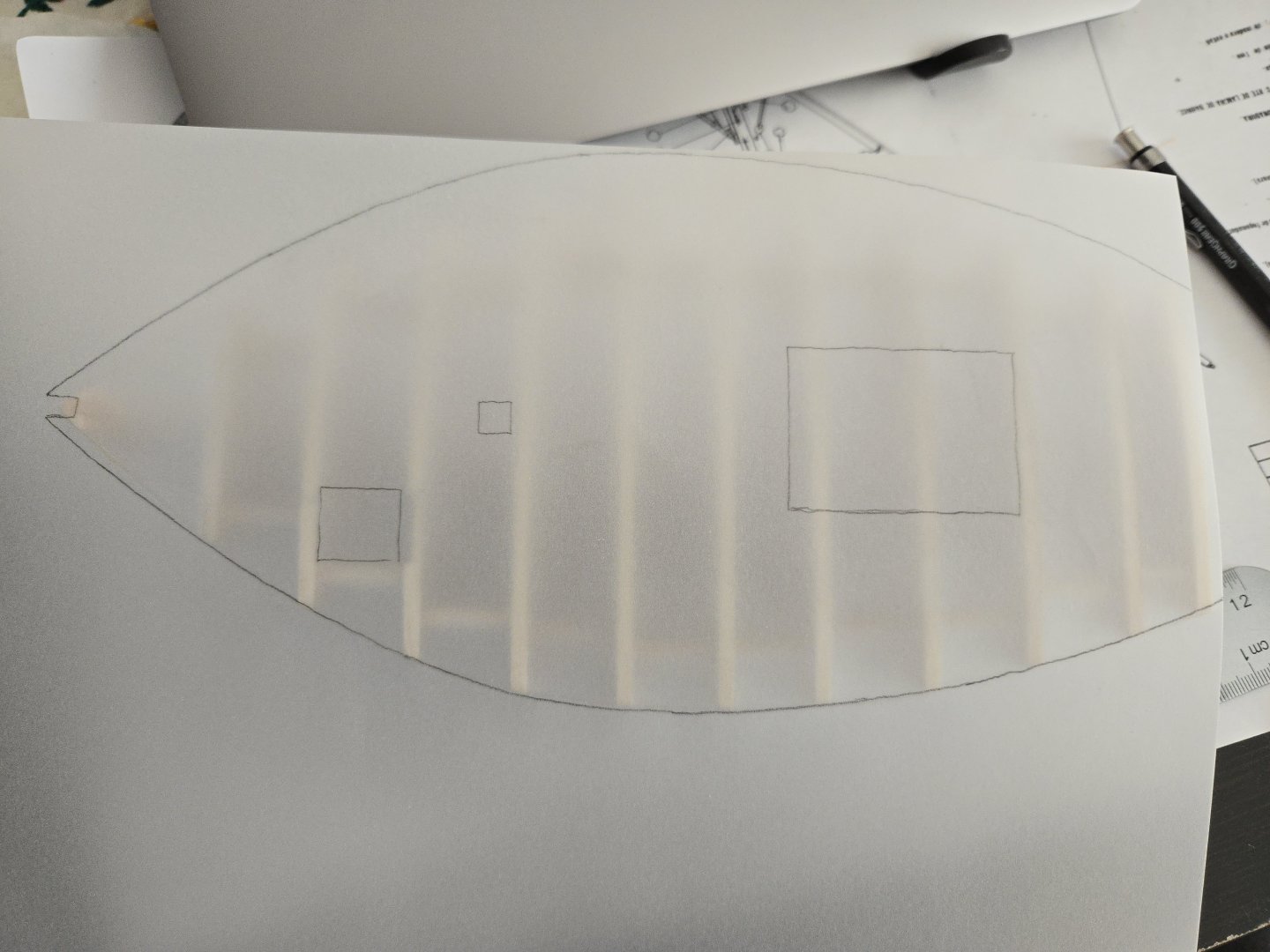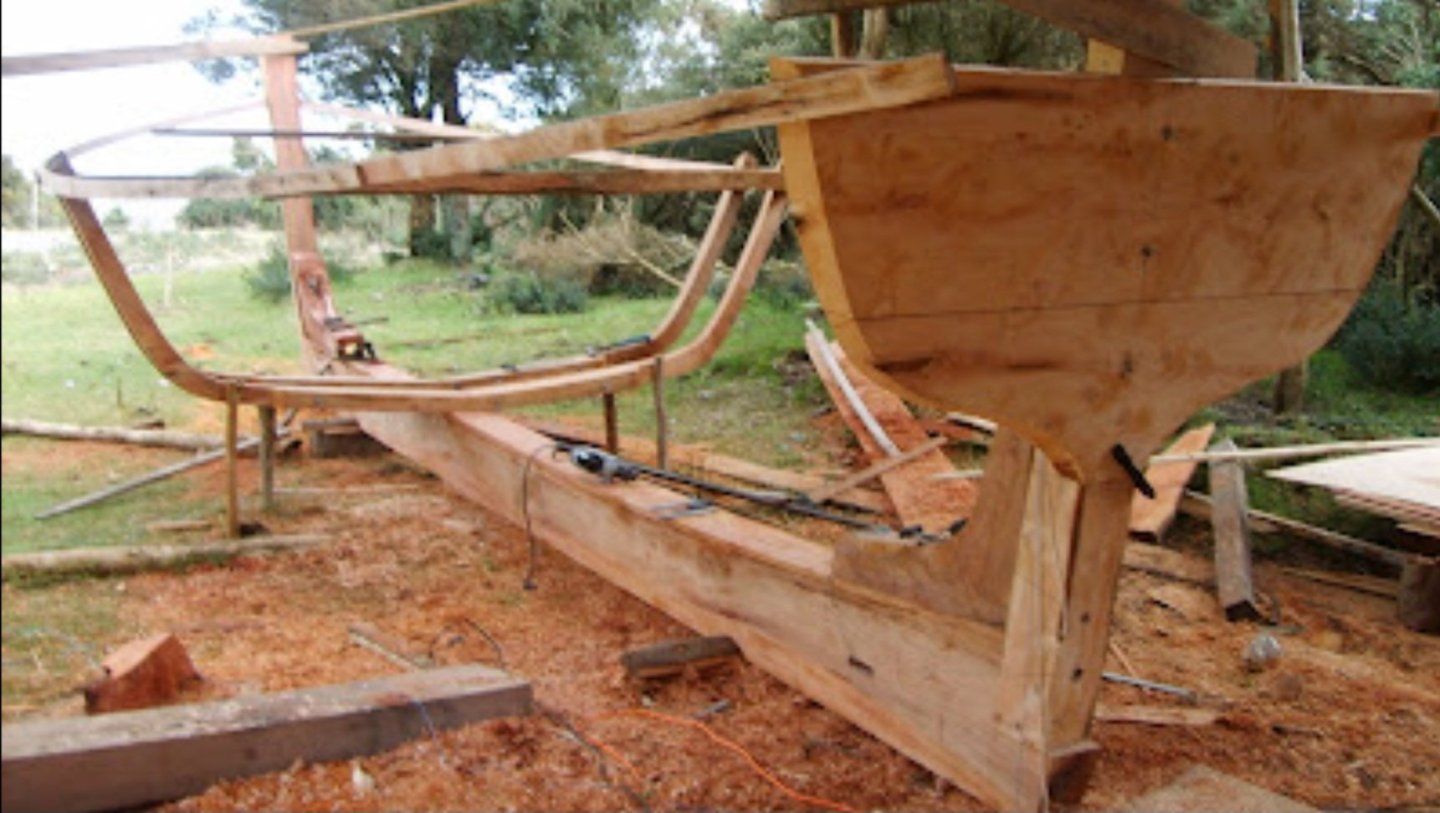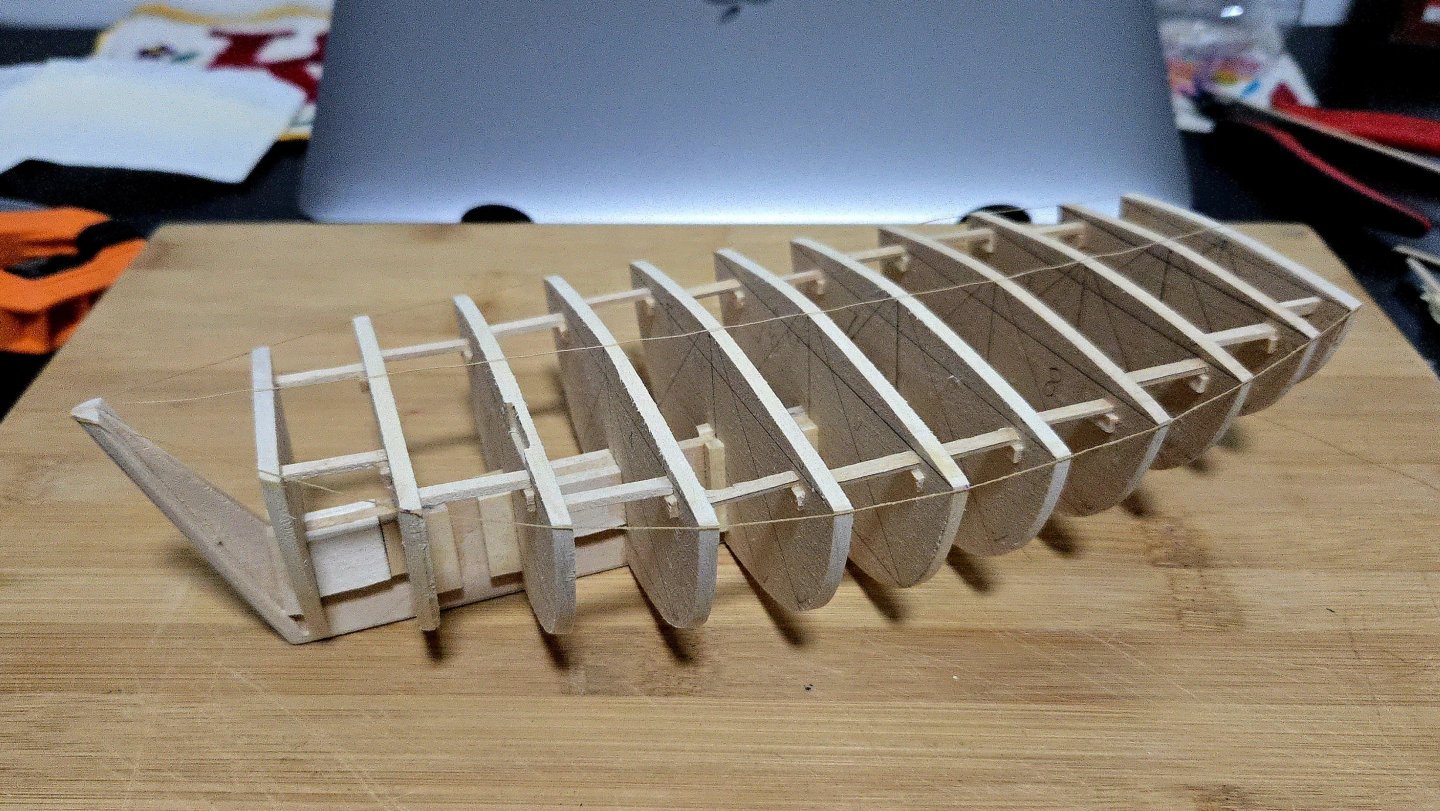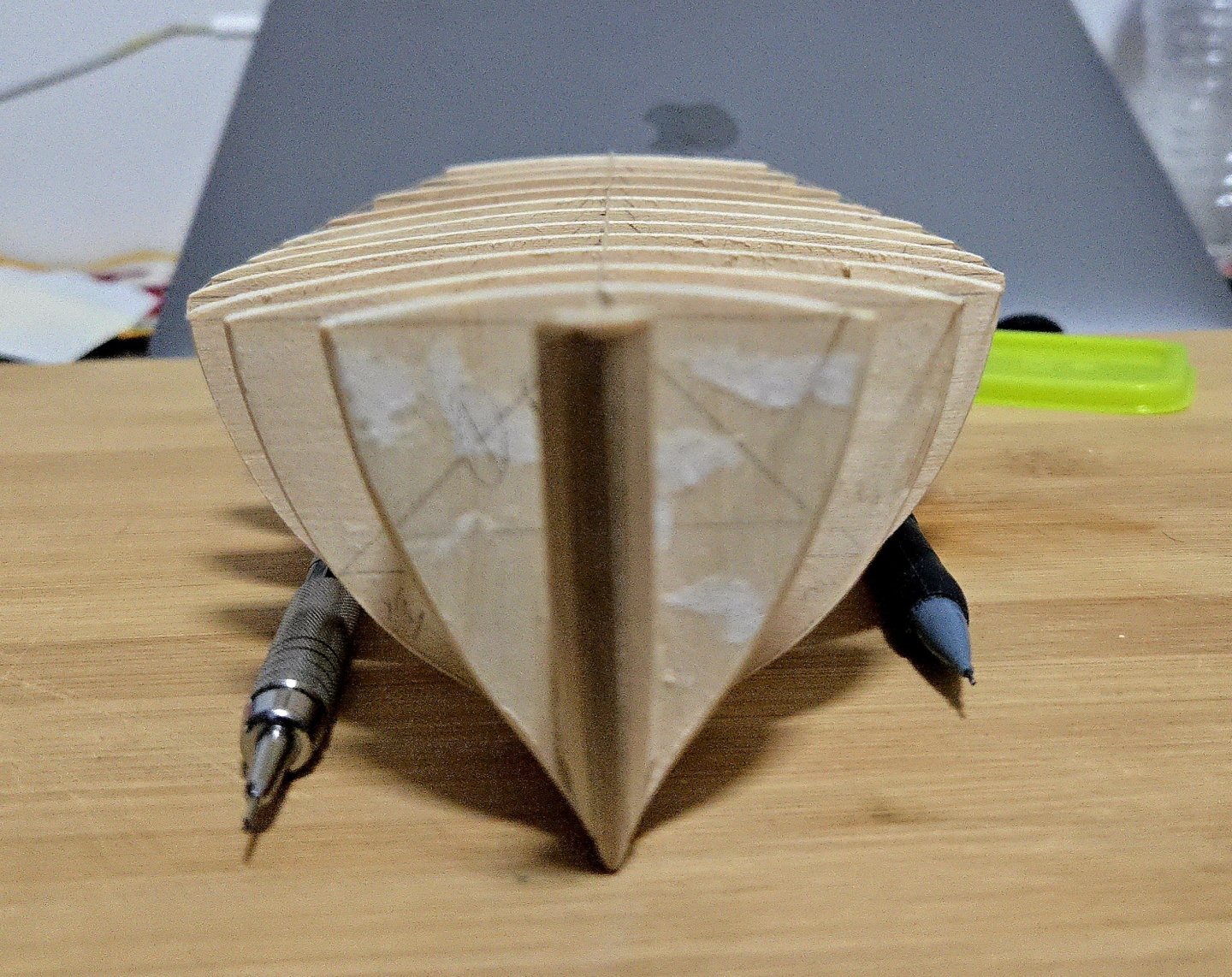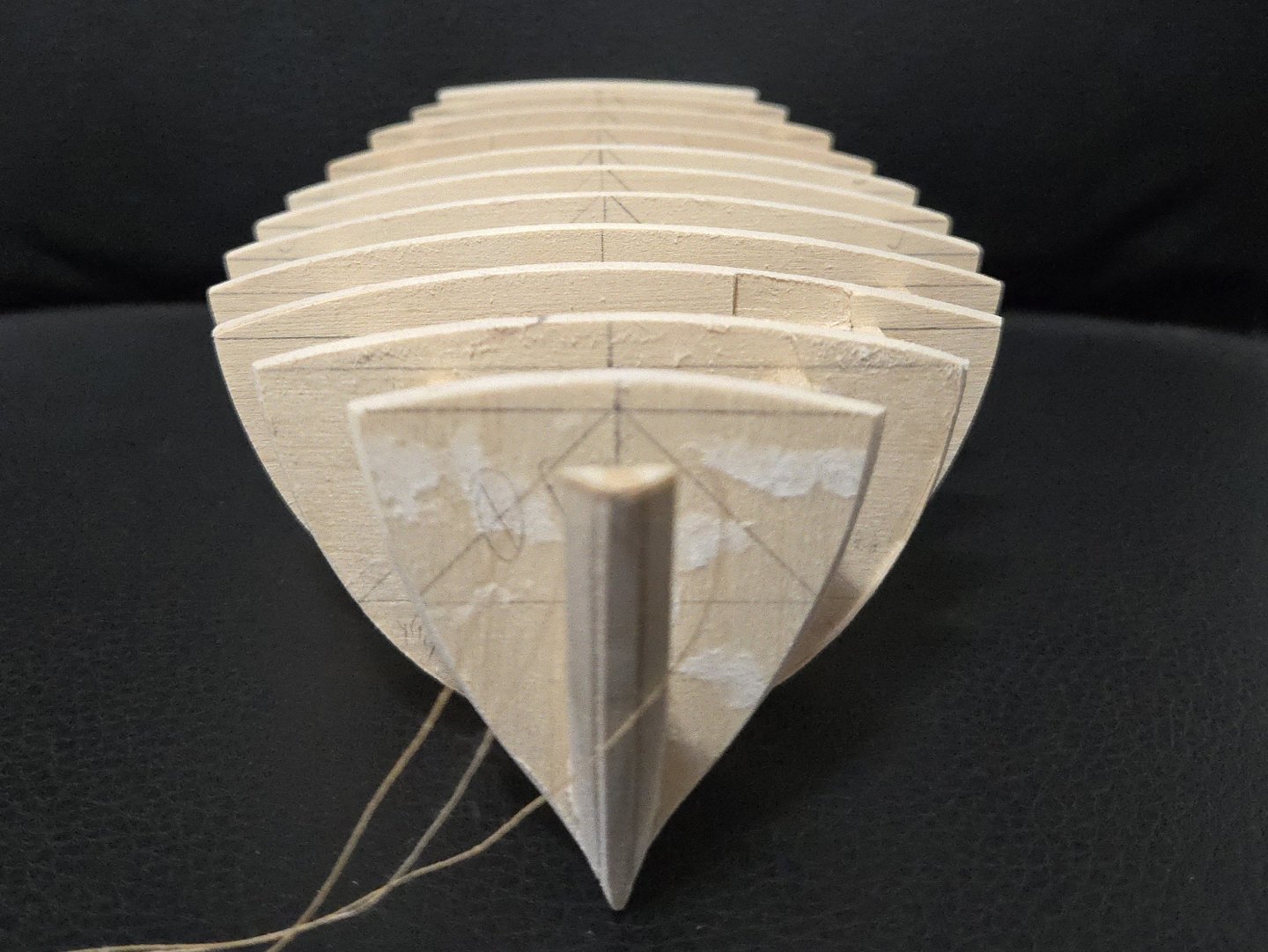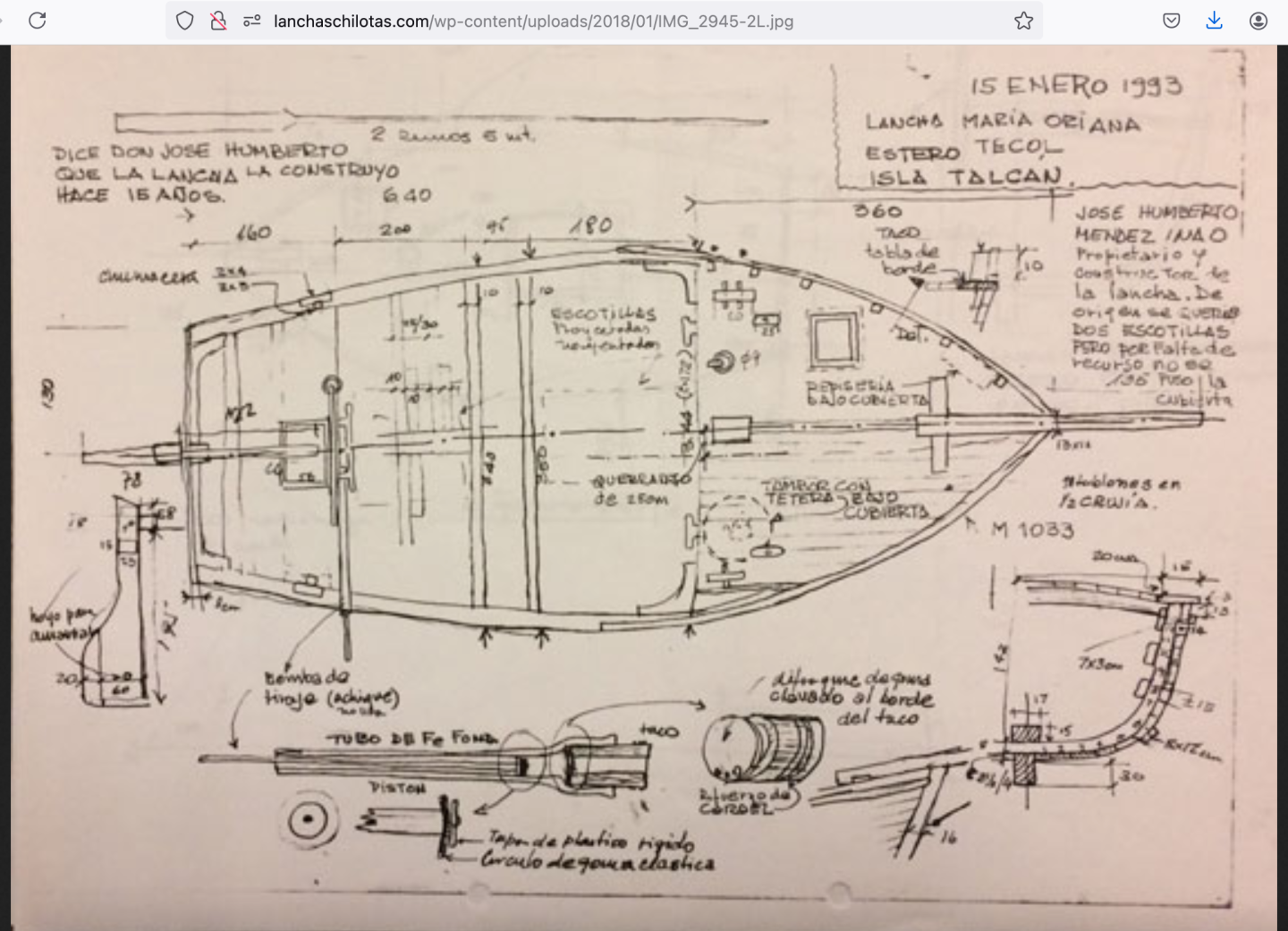-
Posts
1,309 -
Joined
-
Last visited
Content Type
Profiles
Forums
Gallery
Events
Everything posted by JacquesCousteau
-
And a few more photos of the finished build, continuing my previous post (which is more of a reflection on the build):
- 286 replies
-
Finished! I started making this model (or at least drafting my first attempts at plans) on 22 July 2023, and began this build log a few days later. It was my third build overall and my second scratch build. At the time, I thought it would be simple and quick, not much more complicated than the dory I had recently finished, and I thought that I could knock it out in a few months or so while waiting for a kit to arrive. As it turned out, it ended up taking 515 days in total, just under a year and a half, to finish (and 270 posts!). Along the way, this simple build turned into multiple models (including a digression into making some entirely unrelated models as Christmas gifts) and a much deeper dive than I had anticipated into research, opening up a series of questions about, among other things, processes of technological change and intellectual exchange. I also developed substantially in my model-making skills, such that I can see clear differences between the Cargo Canoa (finished about a year ago) and the Canoa de Rancho. This build, and the many helpful comments from so many people, has taught me a lot. Even though it's a simple vessel overall, I tried my best to make it with care and to not shy away from difficulty, even if this meant, for example, tediously re-making the thatched roof. While there are still things that I can see could be improved, I'm happy with how it turned out. This has been an incredibly rewarding build, well worth the time and occasional frustrations, and I'm glad I did it. Below: The Canoa de Rancho, at left, and the Cargo Canoa, at right. I feel like my improvement over time is apparent, although I also wouldn't have been as happy with my results on the Canoa de Rancho without making a lot of mistakes on the Cargo Canoa. (Figure at right for scale.) There were a number of frustrating aspects of this build. To name three specific parts, the thatched rancho took a lot of time and experimentation, the sail was tricky to get right, and the metalwork for the rudder hinges was challenging. More generally, it was difficult at the outset to proceed given that I only had photos to go off and no plans--in this respect, the model is perhaps one of the "models that shouldn't be built" according to Howard Chapelle. That said, I think I was able to produce a reasonable model based as much as possible on existing evidence, especially photos. (And it certainly helps that this vessel has a flat-bottomed, wall-sided hull--a curved hull would be significantly more challenging). Moreover, I've tried to be clear about the choices I've made in interpreting that (sometimes confusing or contradictory) evidence. Some parts of this build are quite conjectural. A lot of the details of the rigging (like the parrel or the robands) were not very clear in photos, but I hope that I've at least provided a reasonable explanation for why I went with the rigging details I went with. Similarly, while I have yet to find a clear photo of the floorboards, other evidence made it clear that they existed, and I hope that I have at least proposed a coherent and plausible explanation of how they might have been. Finally, with better photo evidence coming out over time, I have gradually come to believe that the locker under the helmsman's platform is inaccurate. This is an error on my part, and all that I can say in my defense is that at the time it seemed a reasonable interpretation based on literary sources. Nonetheless, I don't think that we should let the possibility of making such a mistake hold us back. This is especially the case with branching out from modeling vessels that are well-represented in plans and in existing models, including most Latin American workboats--subject that I'm particularly interested in and that I think are well worth building. Ultimately, all that we can do is explain our reasoning and evidence as clearly and compellingly as possible and make a case for why we've made the choices we made. I think the two main takeaways I've had from this build are: 1) This is an excellent, supportive community with a ton of resources. When I had questions about how to do something, I was often able to find existing posts that answered my questions, or I was able to ask and receive a lot of helpful advice about everything from judging hull colors in black and white photos to sail-making. I would not have been able to finish without such a helpful community, and I offer a heartfelt thanks to everyone who followed along, answered or asked questions, offered comments, or just gave the occasional like. It's easy to feel isolated in this hobby, but having so much support and so many examples of excellent builds through this site was really crucial in helping me push forward and strive to improve. Thank you all. 2) Being careful rather than trying to speed through things really pays off. This model took a lot longer than expected, but the end result is worth it. When I was building my NRG Half-Hull kit, I reflected on the advice to treat each plank as a model in its own right. The same can really apply to pretty much any part of any model. For any new modelers out there (as I was when I started this), I can't emphasize enough that taking the time to get everything satisfactory, and even practicing with test pieces, is the key to getting a result that you're happy with. This has been a fun, challenging, and rewarding experience, and I can't wait to continue working on more Latin American (and other) workboats. I'm glad that I was able to capture, in model form, an often under-studied aspect of maritime history, one which was nonetheless important in shaping people's lives and can tell us something about the past. I hope that anyone reading this considers modeling an overlooked subject that speaks to them. This site has an impressive and growing collection of build logs for such vessels, and I can confirm that modeling one is a very worthwhile endeavor, challenges and all. Once again, thank you to everyone for your help and support. I'll include a few more photos in the next post.
- 286 replies
-
After a bit of work, I was able to re-wet, re-shape, and salvage the sail, and the model is now nearly complete. Upon reflection after my frustrating and rather chaotic first attempt, a few things stood out. First, on the positive side, I was happy with how the aft half of the sail (over the rancho) turned out, which spurred me to try to salvage things. Second, while the white glue holding the boltrope in place had stood up to some tests on the sail and seemed like it would hold, the tests didn't involve nearly as tight folds as on the final assembly, and the glue came loose in many places. Fortunately, I was able to use the Aleene's Fabric Fusion to re-glue it in place, and it held up much better (thanks for the suggestion, Glenn!). Third, a big part of the problem was that I needed to furl the sail in contact with the rancho roof to get the shape right, but none of my clamps were suitable to hold things in place, meaning that I needed to press down on the aft part of the sail while trying to shape it elsewhere. This was a recipe for disaster. After thinking a bit more, I realized that I could use thread to tie the sail/yard down over the rancho, and could cut it away later. This worked out--although I could probably have tied it tighter, and I ended up placing a clamp at the aft end solely to weigh it down a little, the thread at least held the piece roughly in place and allowed me to focus on the fore half. Finally, I was using the sheets to wrap up the sail, but I wasn't able to get them very tight, which contributed to some of the loose and awkward folds/draping in the fore half. Upon rewatching Tom Lauria's video about making furled silkspan sails, I noticed that he was able to use a lot of separate ties, using the knots to get things tight. In his case, these were part of the model, but I realized that I could do the same thing with thread, then wrap the sheets over those locations and carefully cut off the thread. This worked much, much better. So, here's the assembly while drying. In hindsight, I would not recommend using wood shims to clamp the sail material, as the wood stuck a little to the sail's glue, but it turned out ok. There were a few places that I wasn't happy with, such as the odd bolt rope shown below--after being reattached, it had come loose again after being folded in a way that made it very difficult to re-attach it precisely to the sail edge. Unless you're looking right at it, though, it's hard to notice and just looks like a fold in the sail, so I decided that I could live with it. In any case, here's the full sail assembly. Overall I'm happy with how it turned out. Next, there were a few loose ends of the rigging to deal with. First, I finished off the parrel (the end of which still needs trimming below). Then the end of the backstay. The looped excess line could be a bit tighter, but I may need to remove the mast and rigging for a possible move in about a year and a half or so, so I've only glued the end of the loop so far. I may try to glue a tighter loop with shellac if I can find any, so it can be easily dissolved in alcohol for removal. Finally, the halyard. I was originally going to run this to the port belaying pin aft, but then I realized that this would only really be done when the yard/sail was hoisted. In most photos, when the yard has been dropped, the halyard just hangs relatively loosely. I've noticed quite a few photos that seem to show the rancho itself (or presumably its framework) being used to belay lines, so I decided to run the halyard through a few loops around the rancho framework near the mast, as though the crew has loosely tied it off to keep it from interfering too much with the fishing gear. At the moment, part of the line has been soaked in a glue-water mix and is being held down with a pair of forceps in order to look like it's hanging naturally. Once this dries, I'll be able to remount the rudder, and the model will be complete!
- 286 replies
-
Thanks! I think I can be my own worst enemy at times trying to match what I see in my mind's eye. In any case, I was able to find the Aleene's fabric glue, so I'm hopeful that the bolt ropes won't fall off if I add them if I make the new sail.
- 286 replies
-
Re-furling the fore half has proven by far the most difficult part of this build. The bolt rope has come off at multiple points from the sail being dampened and re-dampened so often, and it still doesn't seem to be hanging quite how I'd like it. At this point, I'm going to let it dry overnight. Tomorrow I'll see if I can re-glue the bolt ropes. If I'm still unhappy with it, I may re-do the sail, this time with a single layer of filter, less material, and possibly without the boltropes.
- 286 replies
-
Plastic wrap removed for the final drying. At this point, I've decided that the hanging part of the sail forward doesn't look right--without any real weight, it doesn't hang very naturally. I'm going to try to place the plastic wrap over the fore half of the hull and re-furl that part.
- 286 replies
-
Furling the sail has been nerve-wracking, both because I don't want to danage any of the fragile pieces, and because it's a bit of a tricky shape to furl as part of it rests on top of the inclined rancho roof. This necessitates furling the sail on the model itself. So, I first took a bit of plastic wrap to cover everything so the rest of the model wouldn't get wet, and then placed the halyard through the mast sheave. Rather than a really tight furl, I decided to try for a relatively looser one, especially toward the fore end. After a lot of careful folding, wrapping, adjusting, clamping (clamps will be removed before it fully dries), and placing weights, here's how it's looking so far. And after removing some clamps: I'm not sure if I'm 100% convinced by it so far. The fore end looks a little oddly-folded to me. I suppose that I can re-try, though, by rewetting it. Also, as a quick note: on my test version, a single sheet of filter seemed too transparent and flimsy, even after painting and gluing, so I doubled it up then and on this version. I now think that it may have been better to simply go with a single layer, though, as the transparency issue wouldn't matter much on a furled sail, and the fragility can be handled by being cautious. Something to consider for the next build.
- 286 replies
-
The yard and sail are now ready to be attached to the model, furled, and shaped. Tying off the robands was a bit tedious but not difficult. Here it is nearly done, with just a few more left and some ends to trim. And here, after finishing and trimming. I'm not sure quite how accurate my robands are, but I think they're a decent enough representation (see, for instance, the small knots visible in one of the photos in post #260), and they especially will be once the sail is furled. Next, I added the fore and aft sheets, using .5mm rope from Ropes of Scale. I then returned to the parrel, which I had inconclusively tried to figure out earlier. After considering the evidence, three things are clear. First, the parrel forms a pretty big loop around the mast--rather than the small loop I did for the Cargo Canoa, the two ends of the loop should join near the yard itself. Second, there's no photographic evidence of anything like the parrel system used on many Mediterranean lateeners, in which a separate line allows the parrel to be tightened and loosened from the deck. Third, upon close inspection, while the halyard knot itself seems pretty bulky, I'm not really seeing evidence of separate ropes like a parrel running around the yard. All of this makes me think that the parrel was tied off at the end of the halyard around where it was itself tied to the yard. Perhaps this isn't completely accurate, but it's more accurate than what I did on the Cargo Canoa and comports fairly well with the photographic evidence. With that in mind, I tied one end of the parrel around the halyard. The other end will be tied off once the yard is in place on the model. The yard/sail assembly is now ready to go! Here's hoping that moistening and shaping it doesn't make it come apart.
- 286 replies
-
Nice start! On the wood issue: Cherry is a nice wood that's cheaper some of the others that have been mentioned, if you'd like the model to look a bit darker. Rather than buying a bunch of samples and testing them out, you could look at models on this site that you like the look of and see what wood you like. If you search, you'll also find several posts about which types of wood to use. Some say that Beech does a decent job of representing oak in scale, for instance, and others like Alaskan Yellow Cedar, Holly, or other woods. Based on a quick look, Teak seems to have large visible grain which could be a problem for modeling. As for planking dimensions, 1/8-inch thick wood is much too thick for the curves of the hull. People generally use 1/16, 3/64, or 1/32-inch thick wood for planking--something that will easily bend. 1/32-inch curves very well but doesn't leave you with much room for sanding, 1/16-inch may be better for a model of this size. I'd recommend checking what thickness other people have used for planking similar models (such as the Winchelsea, another frigate which has a lot of build logs on this site). The width will depend on whatever was appropriate for the time and place--without doing a lot of research, you could probably just see what other people have used for similar models in this scale.
-
Thanks! Very good eye, I hadn't noticed the wider plank, and excellent question. Looking at other photos of the sane vessel, it seems like it has wider deck planking on the side of the main hatch and where a cleat is located, so it may be structural. Source: https://www.carlosvairo.com/galeria-puerto-montt-lanchas-chilotas That said, photos of other vessels like the Quenita, below, seem to show pretty consistent deck planking, and sketches by José Garnham don't mention anything about wider structural deck planks. Source: https://lanchaschilotas.com/dscn7150-2/ The details of the deck planking are hard to make out in older black-and-white photos. So, the wider planks may well be structural on the vessel that Vairo sailed aboard and photographed, but from other evidence, it doesn't seem like it was a widespread practice. Maybe it was a characteristic of a particular boatbuilder? Thanks for asking, it's definitely an interesting issue.
- 312 replies
-
- Chile
- Latin America
-
(and 6 more)
Tagged with:
-
Unfortunately, I just realized that I made a mistake. Checking photos of the lancha Quenita, it's clear that the deck runs over the top of the transom. Source: https://lavoladorachiloe.blogspot.com/2008_06_08_archive.html?m=0 Unfortunately, I already trimmed the top of my transom planking, so the subdeck will also run over the top. Given that this will all be painted, I may see if I can make the exoosed end of the subdeck invisible with the judicious use of filler and sanding.
- 312 replies
-
- Chile
- Latin America
-
(and 6 more)
Tagged with:
-
A bit more progress. First, on the stern, I planked the transom. Some photos seemed to suggest somewhat wider planks on the transom than on the sides of the hull, so I went with relatively wide planks. (If further evidence suggests that's not accurate, I can just scribe extra plank lines, and this will all be painted anyway). I also used relatively thick, 1/16 inch thick basswood, so as to provide a better gluing surface at the transom. As can be seen, I also started work on the sternpost. On my model, this will just be a small triangular piece, as that's allthat would be visible. On an actual lancha, much of the sternpost is internal, running upwards along the interior of the transom (as seen in the image below of the more recently constructed lancha La Voladora), and rabbeted below it to provide a solid ending point for the plank. Source: https://lavoladorachiloe.blogspot.com/2008_06_08_archive.html?m=0 I cut out the space for the sternpost, then cut it from the same material as the keel: It will be more fully shaped later and then joined with the keel. I also did some more work on fairing the hull and the deck, adding a few shims here and there and sanding down a few high points. This hull is proving very challenging to fair. Partly this is because it's quite a rounded, bulky vessel, but I also have to wonder how accurate the plans are for producing a fair hull or if I screwed up on something. I also started work on the subdeck. The plans include two top-down views of the hull, so I simply traced one on tracing paper. As it turned out, the tracing was a bit off from the model, being overlength (and slightly too wide or too narrow at many bulkheads): I've begun marking up the tracing to get a better fitting subdeck. I plan to make one that's slightly oversized and then sand it down.
- 312 replies
-
- Chile
- Latin America
-
(and 6 more)
Tagged with:
-
Thanks for the suggestions! I may have to get some fabric glue, but for now, I'm trying a bit of undiluted white glue. I added the bolt rope and marked and cut out the holes in the sail to attach it to the yard. I've been wondering how best to lash the sail to the yard. A wide range of methods have been used historically, from a simple loop around the yard to complex robands. I know that many small vessels with similar rigs use a single line to do it (although often not with a simple loop). However, in looking at the photos I've found of canoas, it seems more like they used separate, relatively simple robands--I have not seen any photos showing evidence of a rope running the length of the sail (besides the boltrope). See below: Source: https://www.mexicoenfotos.com/antiguas/jalisco/chapala/un-velero-panorama-MX14561525002424 Or here: Source: https://www.mexicoenfotos.com/antiguas/jalisco/chapala/cargamento-de-entre-MX14652247742300/5 So, I've decided to just do separate, simple knots (secured with super glue) at each tie-off point. I've started with the central pair around the halyard, which will keep the yard from slipping away. I still need to trim the ends.
- 286 replies
-
Thanks! I had noticed that the botter looked pretty different from the lancha in hull shape and use of leeboards, but I didn't realize that the construction details were so different as well. That's also fascinating about the dhows and Inuit vessels. It's worth noting that Chiloé wasn't alone in Chile in shifting away from traditional vessels to more European-style boats. Maino Prado also briefly discusses the replacement of traditional seal-skin and reed rafts in the fishing industry with wooden chalupas and similar vessels in the 19th century. As for who built (and owned) lanchas, this is a topic I need to research more, but it seems likely that there was some degree of specialization involved--less "everyone built boats in their backyard" and more "most carpenters, of which there were many, had at least some boatbuilding knowledge"--but this is a subject for further work.
- 312 replies
-
- Chile
- Latin America
-
(and 6 more)
Tagged with:
-
While I slowly add the bolt rope to the sail for my Canoa de Rancho build (which should be finished shortly!), I've gotten back into the Lancha Chilota. When I left off, I was trying to figure out the deck camber, as it was apparent from photos that the camber given in the plans was excessive, but I couldn't find anything about what the actual camber should be. Fortunately, I was poking around José A. Garnham's website and found that it includes a number of his sketches from research giving various dimensions from several lanchas and other vessels in the early 1990s. (Oddly, the sketches don't seem to be linked to from any of his posts, but are findable if you view a photo and use the buttons below it to scroll, one photo at a time, through all photos). Among them was one drawing of the Maria Oriana, an admittedly unusual lancha--it was only decked on the foreward half, as the owner ran out of resources at the end to completely deck it--that specified a camber of 20 cm, or just under 8 inches. (I wonder if this vessel's camber was recorded, unlike that of other vessels sketched, because the odd deck arrangement made it much easier to measure without having to go below deck). Source: http://lanchaschilotas.com/wp-content/uploads/2018/01/IMG_2945-2L.jpg This was a big relief. Based on some other vessel types, I had been considering going as low as 3-4 inches of camber, but knew this would throw off the lines of the top of the hull, given that the plans specify about 12 inches of camber. 8 inches of maximum camber seemed much more doable. So, I marked out the new deck height on the bulkheads, based on the proportions (2/3 of existing camber). I then used my mini-plane and sanded. As I got close, I began checking with a batten for fairness. Ultimately, I only reached the fully reduced camber on a few frames, but the others are within 1/32-inch (or 1 inch at scale) in order to keep the deck properly faired. I can live with a maximum deck camber of about 9 inches instead of 8, as it's much closer to accurate than 12 was. The lines of the deck now look much flatter, and the model should look much closer to the photos I've seen. Before: After: I also added some thread along the sheer line on both sides to check alignment, finding a few edges that needed to be raised or lowered. Of course, it's only upon taking the photo below that I realized the thread had popped off the first bulkhead, which was easy enough to fix. I've also been using a batten along the top of the bulkheads to fair the deck besides just at the center line and sheer lines. Once the top is fair, I'll be adding a 1/32‐inch false deck--this will be my first planked deck so I'd like a firm backing--and then will be adding a sternpost and then planking the hull.
- 312 replies
-
- Chile
- Latin America
-
(and 6 more)
Tagged with:
-
Thanks! I'll have to check if it's available here, sounds very useful.
- 286 replies
-
Thanks! It's good to know it's not just me. Slight hiccup in my plans. After cutting out the sail, I began gluing on the boltrope (0.35mm from Ropes of Scale) with white glue. I glued along the foot first. As usual, I had trouble getting the rope to stick right close to the edge of the sail. Before I went farther, I decided to test whether the boltrope would hold when the sail was moistened and furled up--after all, the sail is covered in a mix of the same white glue, which becomes quite flexible when dampened. In general, the glue held, but there were a few points where the boltrope came off, especially while wrapping up the sail. As a result, I'm debating whether to include a boltrope or not. It would certainly be more accurate to include it, but I'm a bit worried about it coming partly off midway through furling and ruining the sail, especially as the furled sail will be much more rolled-up than I did in my brief test. I'm also debating how visible the bolt rope will really be. My sense from the test sails, like below, is that the edges of the sail really aren't very visible among all the folds. The presence of ropes used to wrap up the sail also may "trick the eye" into not really noticing if the boltropes are missing. While the boltropes seem like they would only maybe be visible in a few parts on a sail furled up like in the photo below. Source: https://memoricamexico.gob.mx/swb/memorica/Cedula?oId=vvts2osBVs6S4R6nk8il In any case, it's something for me to consider.
- 286 replies
-
It's been a while since the last update, but I've finally been able to make progress again, and I'm in the home stretch. First, as mentioned earlier, the grapnel anchor I had used turned out to be inaccurate, so while visiting family for Thanksgiving, I ordered a different anchor. Unfortunately, given shipping times and prices, I was only able to get one with a wooden stock, while photos make it clear that they used metal stocks. That said, everything I've read says that Britannia metal is pretty soft, and that's been my experience with filing off flash, so I decided to see if I could modify it to fit a metal stock. The anchor kit with the wooden stock. Like the grapnel, it's 20mm long. Unlike the grapnel, it came pre-blackened, although I painted everything in the end anyway. Drilling a new hole in the shaft by hand was a very slow process. It doesn't help that most of my cheap drill bits have a totally flat rather than a pointed tip, which is fine if you're drilling into basswood but seems to slow things and makes the drill bit slip easily when drilling into metal. I had to use a larger, sharp-tipped drill bit to mark the initial hole. It was also tricky finding the right pressure to place, as you do need some to make the bit cut into the metal. I learned how fragile drill bits can be: my thinnest one abruptly bent under the pressure. Alas, poor drill bit. Nonetheless, after what seemed like a very long time, I finally got a hole through the shaft. I was then able to superglue a length of brass rod in place to make the new stock. The whole anchor was then painted. Finally, I removed the grapnel and affixed the new anchor to the end of the chain. I'm sure I can find a use for the grapnel on another build. I'm pleased with how the anchor turned out, it looks much more accurate. Compare with the anchor in this photo: Source: https://memoricamexico.gob.mx/swb/memorica/Cedula?oId=g_ts2osBVs6S4R6nsc0d Besides the anchor, I was also finally able to find some large coffee filters, and have begun work on the sail. The end of the build is in sight!
- 286 replies
-
Best of luck with the project! One question: why not borrow the lines of an existing pilot cutter? There are a number of hull plans available in books like Greenhill and Mannering's Inshore Craft that would lend themselves to a plank-on-bulkhead build, and it would be entirely possible to come up with your own deck arrangement to personalize the build. Just a thought.
-
After a very relaxing family visit, I’m looking forward to getting back to the build. But first: by now I've discussed why the lancha chilota developed, how it changed over time, and some variations in hull form, but I haven't yet written much about how the type developed. The reason is because I have more suggestive leads and intriguing possibilities than clear answers. Despite that, I still think it's worth at least putting some thoughts and notes down, even if what follows rambles a bit. Broadly, while I don’t think it’s possible to plot out a direct line of development for the lancha chilota, what is clear is that 1) European shipwrights played a prominent role in the 19th-century shipbuilding industry in Chiloé and in Chile more generally, 2) Chilean boatyards and shipyards built large numbers of sloops, schooners, and other gaff-rigged, frame-built coastal traders, and 3) by the late 19th century, Chilean shipwrights increasingly focused their attention on smaller vessels due to economic changes. Given this context, we can understand how the lancha chilota came about in general terms. As I’ve mentioned earlier, the lancha chilota originated in the area of the Chiloé archipelago in the late 1800s, alongside other vessels like the open, double-ended chalupa and the partially-decked chalupón. These vessels drew on Euro-American boatbuilding techniques, which came to replace the sewn-plank construction method that previously dominated the region. It's difficult to be more specific than that, though, or to point to more direct routes of influence that created the lancha, as there’s a lot about its origin that’s unclear. A lot of existing writing is vague on the issue if not of dubious accuracy. For example, Hollander and Mertes, in The Last Sailors, describe the lancha as a direct descendant of the conquistadors' caravels. This strikes me as implausible given the vast differences in hull form and rig, and, crucially, given that chilote boatbuilders seem to have preferred sewn-plank dalcas over European-style vessels for centuries, making it unclear how they would have maintained a building tradition that would have allowed the caravel to slowly develop into the lancha over centuries. Meanwhile, José A. Garnham's Lanchas chilotas: un patrimonio histórico y cultural de Chile (Santiago: Ricaaventura, 2017) fortunately has its first chapter, about the origins of the lancha, digitally available as a sample ( https://www.ricaaventura.cl/catalogo/lanchas-chilotas-un-patrimonio-historico-y-cultural-de-chile-2/ ). Although the chapter contains some interesting hints, Garnham has to admit that the lancha's origins are unclear. Some writers, he reports claimed that the lancha developed from the dalca. Although they clearly fulfilled similar functions, a straightforward line of development strikes me as unlikely due to the absence of shared techniques or hull forms between the two vessels. Others, Garnham writes, suggested that the lancha drew more on European examples and maritime traditions. One chilote reported that a French research group thought the lancha looked similar to Breton vessels of the 18th Century. It's not clear to me, though, how such vessels would have been transmitted to Chiloé, which was an isolated outpost of the Spanish empire at the time. Others suggested that it developed from Galician small craft, as the early Spanish colonists were Galician. This is perhaps more plausible as it suggests a clear route of transition, yet it's unclear how this theory comports with the clear dominance of the dalca for centuries. Still others pointed to the brief Dutch occupations of Chiloé in 1600 and 1643 to suggest Dutch influence, claiming that the lancha was similar to the botter. But it's unclear whether the Dutch even built vessels locally during their very brief occupations. As a point of compsarison, while the Dutch may have influenced the Saveiro of Bahia in Brazil, a different type of coasting vessel, their occupation of Northeast Brazil lasted 24 years and involved a substantial number of people. It was a far deeper-reaching enterprise than their brief occupations of Chiloé. Not to mention that the lancha does not strike me as being all that similar to the botter, other than both being small gaff-rigged sloops with fairly flattened bottoms. In any case, none of these are really conclusive, and Garnham concludes the chapter reflecting on the type's uniqueness (Garnham, pg. 17-19). I agree that we can't draw a straight line to the lancha from any particular European vessel. Small vessels, many of them decked with transom sterns and gaff rigs, were common all around the European Atlantic coast but in uncountably diverse forms, reflecting both local boatbuilding traditions as well as broader influences, at times leading to cases of convergent evolution. For instance, to follow up on the possible Galician influence mentioned in Garnham, the northern coast of Spain has long been a hotbed of maritime activity, and a number of distinct local types had emerged by the late 1800s. One of these, the galeón gallego (not to be confused with the galleon of the 1500s), shares similarities with the lancha chilota, being a capacious, decked, gaff-rigged sloop of similar dimensions and similar purposes, one which was also often beached by the tide for cargo handling. Yet there are clear differences, as well--notably, the galeón generally had a round rather than a transom stern. Rather than a case of direct influence from galeón to lancha, the two vessels seem to be a case of convergent evolution, with boatbuilders drawing on similar elements in order to build somewhat similar vessels for similar conditions. (For a brief history of the galeón gallego and related vessels, amply illustrated by photos, see the link in the photo source below). Below: A galeón gallego, a type of Galician coasting sloop. Source: https://bluscus.es/historia-de-los-galeones-gallegos-industriales-y-practicos/ Yet this doesn't answer the question of how European-style boatbuilding techniques and rigs replaced other, more local styles in Chiloé. To understand potential routes of influence, I turned to other sources. The most useful source—one which I only found after spending a good bit of time combing through census records and early lithographs of ports—was Valeria Maino Prado’s La navegacieon del Maule. Una vía de conexión con el exterior, 1794-1898 (Talca, Chile: Editorial Universidad de Talca, 1996). (The book is available in full for download from the Chilean National Library here: https://www.memoriachilena.gob.cl/602/w3-propertyvalue-128835.html ). Although it focuses on the Maule region, which is several hundred miles to the north of Chiloé, and it doesn’t much discuss the specifics of boatbuilding, it’s an extremely useful source for understanding broader Chilean shipbuilding and coastal trade from the colonial period to the late 19th century. The book doesn’t explicitly tell us how the lancha chilota developed, but it provides a lot of information that helps contextualize it, helping propose a way of understanding its emergence. According to Maino Prado European shipwrights played an important role in 19th century Chile. During the colonial era, European-style shipbuilding in Chile languished until the Bourbon reforms of the late 1700s, when Spanish authorities sought to improve the productivity of their empire to better compete with France and Britain. Spanish expeditions had determined that Chile had good sources of lumber for shipbuilding, and with new laws allowing free trade between Spanish ports and the empire, a small number of shipbuilders from the north of Spain—Basques, Galicians, and Asturians—arrived in Chile, setting up shop especially near the Maule river and beginning to build a number of vessels, some of them quite sizeable ocean-going ships (Maino Prado, 16-21). The wars of independence opened Chile to trade with the rest of the world and led to foreign shipwrights immigrating to the country to establish shipyards and boatyards. Among them were British (some of whom came with former Royal Navy officer Thomas Cochrane when he led the Chilean insurgent fleet), French, Germans, Americans, and Italians. In fact, as Maino Prado makes clear, the Chilean shipbuilding industry was marked by the prominent presence of foreigners. From the mid-1830s to the mid-1840s, for example, there were just two Chilean-origin shipwrights in the important Maule port of Constitución, along with six British shipbuilders, three Germans, and one Frenchman (Maino Prado, 37). Foreign shipwrights brought with them the latest in European ship design and techniques, and actively sought to adapt them to local conditions—in Constitución, for instance, Maino Prado details their efforts to create shallow-draft vessels that could easily pass over the bar at the Maule River’s mouth (Maino Prado, 28-29). Maino Prado and other sources further highlight the important role of foreigners in Chiloé’s maritime sector, as well, beyond Chile as a whole. Although it’s not the focus of her book, Maino Prado notes that Chiloé also became a major center in the Chilean shipbuilding industry in the 19th century, building nearly as many registered vessels as Maule shipwrights did in 1849-1858, for example (Maino Prado, 42). As elsewhere in Chile, foreign shipwrights played an important role. In the period 1850-1866, for example, Chiloé had one British, four French, and ten Chilean-origin shipwrights (Maino Prado, 48). As a side note, Maino Prado thus paints a rather different picture of Chiloé than that given by Anton Daughters in Memories of Earth and Sea (an ethnographic work on Chiloé history and identity that I’ve discussed earlier). While Daughters emphasizes Chiloé’s isolation in the nineteenth century, Maino Prado shows that Chiloé was an important center of national shipbuilding and that foreign shipwrights played an important role. Census records from 1875, 1885, and 1895, which I also examined, suggest how both scholars have a point. To Daughters’ point about Chiloé’s isolation and the continuation of small-scale, near-subsistence level economic activities among many Chilotes, census data makes it clear that Chiloé had very few foreigners overall—just 217 in 1875, out of a province-wide population of 64,536—and that labor specialization was only in its infancy in the period. While other sources make it clear that Chilotes regularly engaged in fishing for subsistence and for small-scale trade, for instance, there were only 18 people in 1875 who gave their profession as fishermen, meaning that most fishing was done as a supplemental activity by people who combined fishing with other activities (mostly farming on small farms, the most common “profession” given in the census). Much the same could be said of coastal trade—despite other sources being clear that the archipelago was linked by a thriving coastal trade, which was only growing with the expanding timber industry of the late 1800s, only 206 people gave their occupation as “sailors” in 1875, so many Chilote coastal traders would have been people who viewed sailing as a supplemental activity. On the other hand, foreigners were clearly concentrated in maritime industries. It’s difficult to track shipbuilders, as censuses seem to have lumped many under the generic “carpenter” category (in 1875 a single person was listed as a “calafate,” a term generally referring to a small-scall boatbuilder and caulker/repairer, and one person was similarly labeled a “naval constructor” in 1885), but of the 206 sailors in 1875, 70 of them were foreigners, many of them American, British, German, and Spanish. All of which is to say that, while Chiloé was indeed marked by the continuation of small-scale landholding and unspecialized labor systems (allowing for the cultural continuities Daughters identifies), the maritime sector was nonetheless particularly marked by the presence of foreigners, which helps us to understand how the lancha chilota developed with foreign influence even if we can’t fully trace specific influences. (I should also note that the nearby mainland province of Llaniquihue had many more foreigners, especially Germans, including a number in the port city of Puerto Montt, although it's not clear from the census how involved they were in shipbuilding and coastal trade). Finally, Maino Prado and other sources also highlight that there was a thriving Chilean coastal trade carried out in hundreds of relatively small vessels in the nineteenth century, many of which were locally built in Chile following European-style designs. Although she doesn’t provide the particulars of ship design due to a lack of sources, Maino Prado uses registries to trace ship and boat construction, general type, and tonnage. There was a great deal of variety, but in general, while Chilean shipwrights in the first half of the 1800s regularly built everything from small sloops (balandras) of 20 tons or so, up to full-rigged ships of several hundred tons, Maino Prado notes that there was a shift toward smaller coasting vessels—especially schooners, which rapidly overtook brigs and sloops, likely for the same efficiency reasons that US coastal trade underwent the same change—in the later 1800s. This had a number of causes, including the difficulties that Chilean shipwrights (who built with wood) had in competing with large metal-hulled foreign steamships that became more prominent in oceanic trade with the construction of the Suez Canal, the expansion of coastal trade routes and small-scale coastal trade in response to the Spanish blockade of major Chilean ports in 1866, and the growing need for coastal trade to supply the expanding nitrate industry (Maino Prado, 52, 63-68, 79-80). In any case, Chilean shipwrights increasingly concentrated on smaller vessels, until by the late 1800s most were largely focused on building harbor lighters and similar craft (which, concurrently, became increasingly large in this period due to the growth of oceanic trading ships) along with some coastal traders. Chiloé was hardly immune to such developments, building a large number of European-style vessels. The 1875 census, for instance, records that the port of Ancud in Chiloé had a yearly entry of 132 ships averaging around 570 tons each, and that the province’s lumber trade and local commerce in that year involved some 20 schooners of 120-130 tons each and 213 sloops of 40-50 tons each (tonnages that should be treated as very rough estimates--I should also note that it's unclear to me whether is counting all coasting vessels that passed through, or just ones that were registered in Chiloé province). Maino Prado also includes, on the basis of admittedly incomplete data, registries for a number of vessels built in Chiloé in the 19th century for local and national owners, ranging from sloops in the 20-40 ton range, schooners in the 40-50 ton range, up to a few ships of several hundred tons. Details, unfortunately, are few and far between about such coastal traders, in Chiloé and elsewhere in Chile. I haven’t had much luck finding anything specific in early images of Chilean ports (for an interesting blog post on early images of Puerto Montt, including on lithographers’ practice of adding fictional generic vessels to harbor scenes in order to promote ports, see: https://ceph-puerto-montt.blogspot.com/2011/03/nuevo-orden-cronologico-primeras.html?m=1 ). Nonetheless, a couple points are clear and have important implications for the development of the lancha chilota. First, Chiloé’s (and Chile as a whole’s) maritime sector had a high degree of foreign, especially European, influence from the early 1800s onward, and a wide variety of vessels were built in Chilean shipyards and boatyards. There were clearly many paths, then, through which European techniques could take root in Chiloé, allowing for the development of the lancha chilota. Second, Chilean shipbuilding over time developed to specialize in the production of smaller vessels, including open harbor lighters and decked 1- and 2-masted, gaff-rigged coastal traders. Aspects of both types may have influenced the lancha chilota, which could plausibly be seen as either a decked and rigged version of an open launch, or as a miniaturized version of a coastal trading sloop. This tendency toward producing smaller vessels would have especially met the needs of Chilotes for small, cheap, but capacious and seaworthy vessels to link together the archipelago’s scattered towns and farms. All of which is to say: it’s likely impossible to trace an exact route by which the lancha chilota came to be. Barring further information, such as shipwrights’ memoirs, extensive shipbuilding plans, or other sources that likely don’t even exist today (although I’d love to see more research on this), we can’t plot out a straight line from, say, some particular European coastal sloop to the lancha chilota. But we can see how the lancha chilota developed and replaced the sewn-plank dalca in the context of extensive European influence in ship- and boat-building, and a general economic-driven trend in Chilean shipbuilding to focus on ever-smaller vessels.
- 312 replies
-
- Chile
- Latin America
-
(and 6 more)
Tagged with:
-
Very nice job, the added keel really brings it to life and differentiates it from other peapod builds.
- 44 replies
-
- maine peapod
- peapod
-
(and 4 more)
Tagged with:
About us
Modelshipworld - Advancing Ship Modeling through Research
SSL Secured
Your security is important for us so this Website is SSL-Secured
NRG Mailing Address
Nautical Research Guild
237 South Lincoln Street
Westmont IL, 60559-1917
Model Ship World ® and the MSW logo are Registered Trademarks, and belong to the Nautical Research Guild (United States Patent and Trademark Office: No. 6,929,264 & No. 6,929,274, registered Dec. 20, 2022)
Helpful Links
About the NRG
If you enjoy building ship models that are historically accurate as well as beautiful, then The Nautical Research Guild (NRG) is just right for you.
The Guild is a non-profit educational organization whose mission is to “Advance Ship Modeling Through Research”. We provide support to our members in their efforts to raise the quality of their model ships.
The Nautical Research Guild has published our world-renowned quarterly magazine, The Nautical Research Journal, since 1955. The pages of the Journal are full of articles by accomplished ship modelers who show you how they create those exquisite details on their models, and by maritime historians who show you the correct details to build. The Journal is available in both print and digital editions. Go to the NRG web site (www.thenrg.org) to download a complimentary digital copy of the Journal. The NRG also publishes plan sets, books and compilations of back issues of the Journal and the former Ships in Scale and Model Ship Builder magazines.



